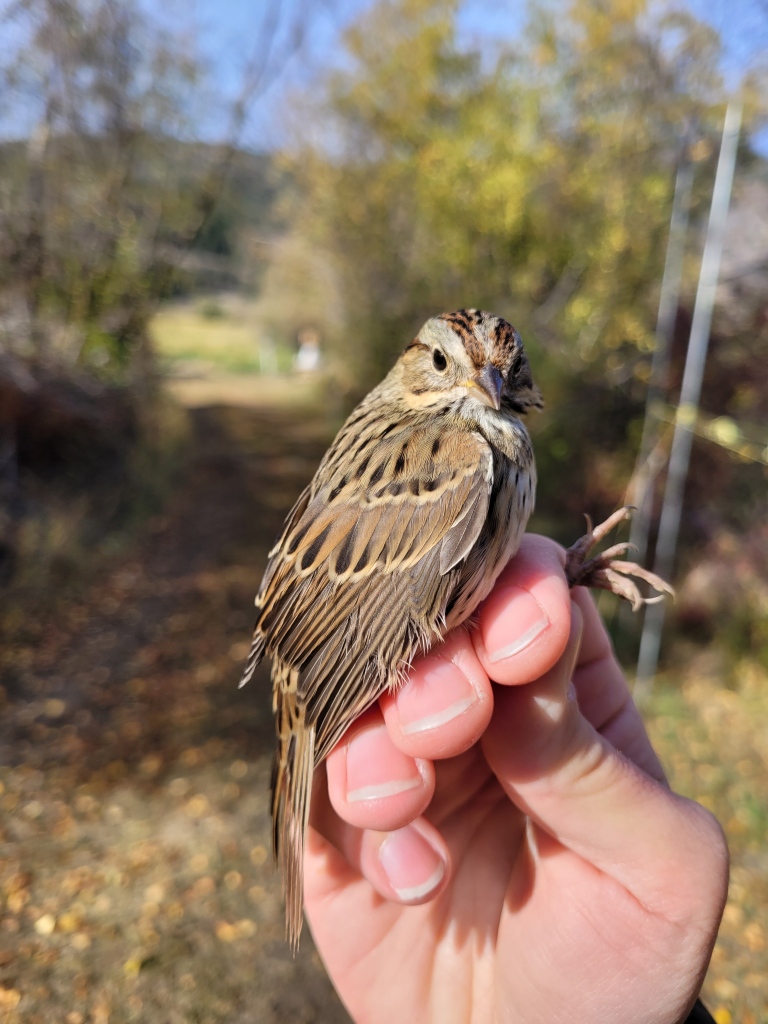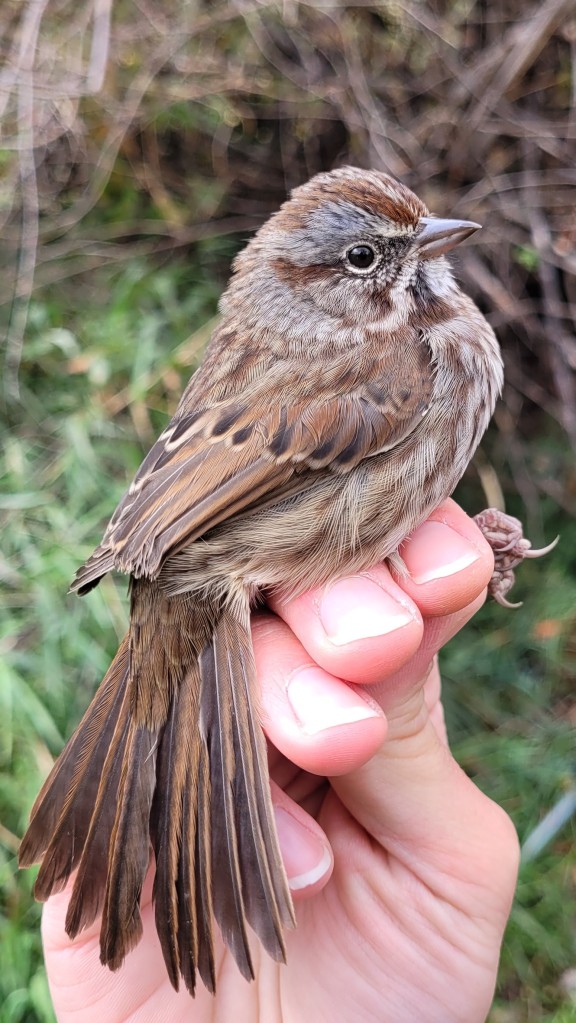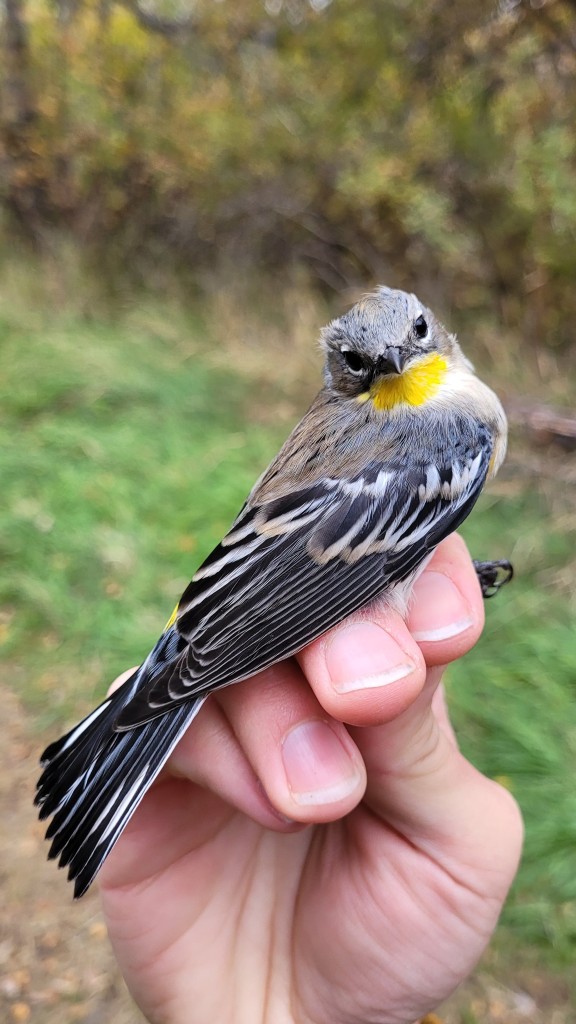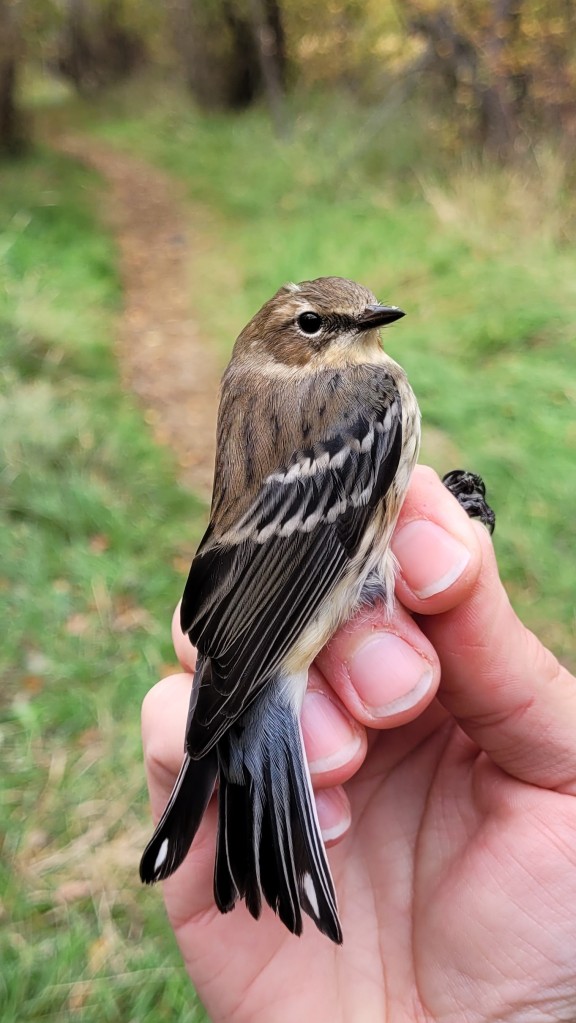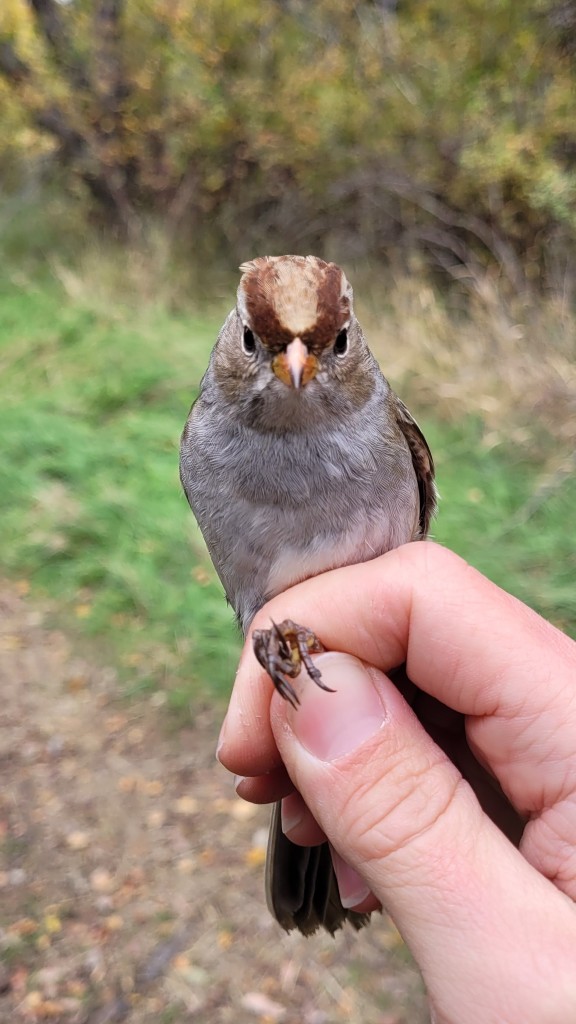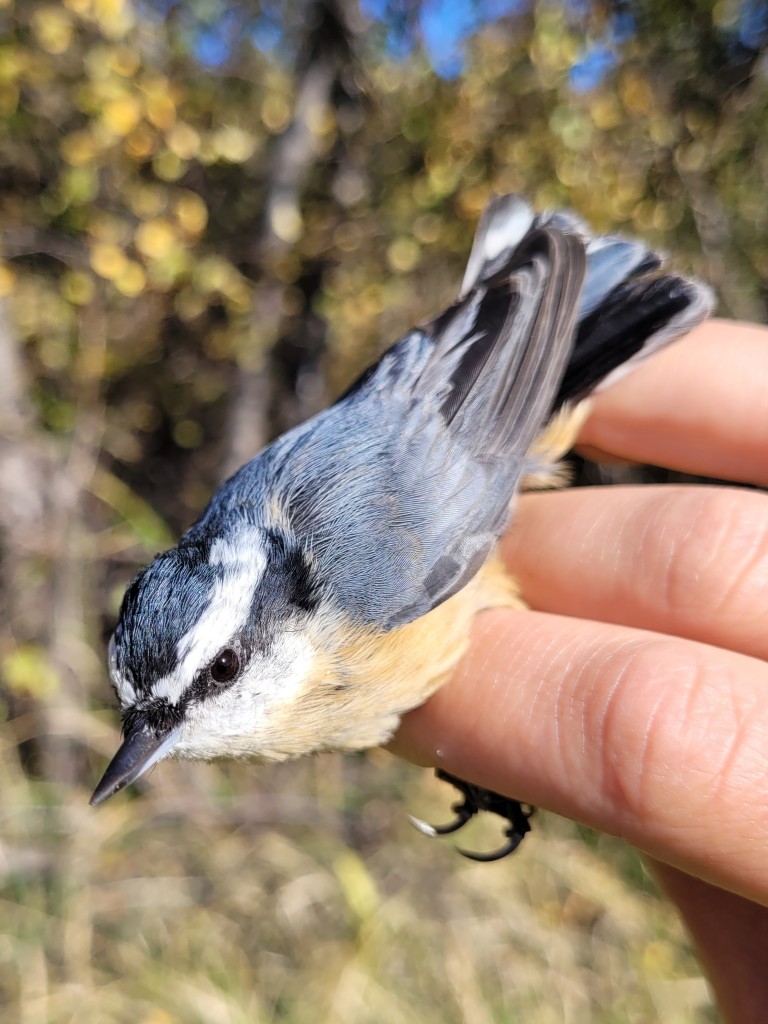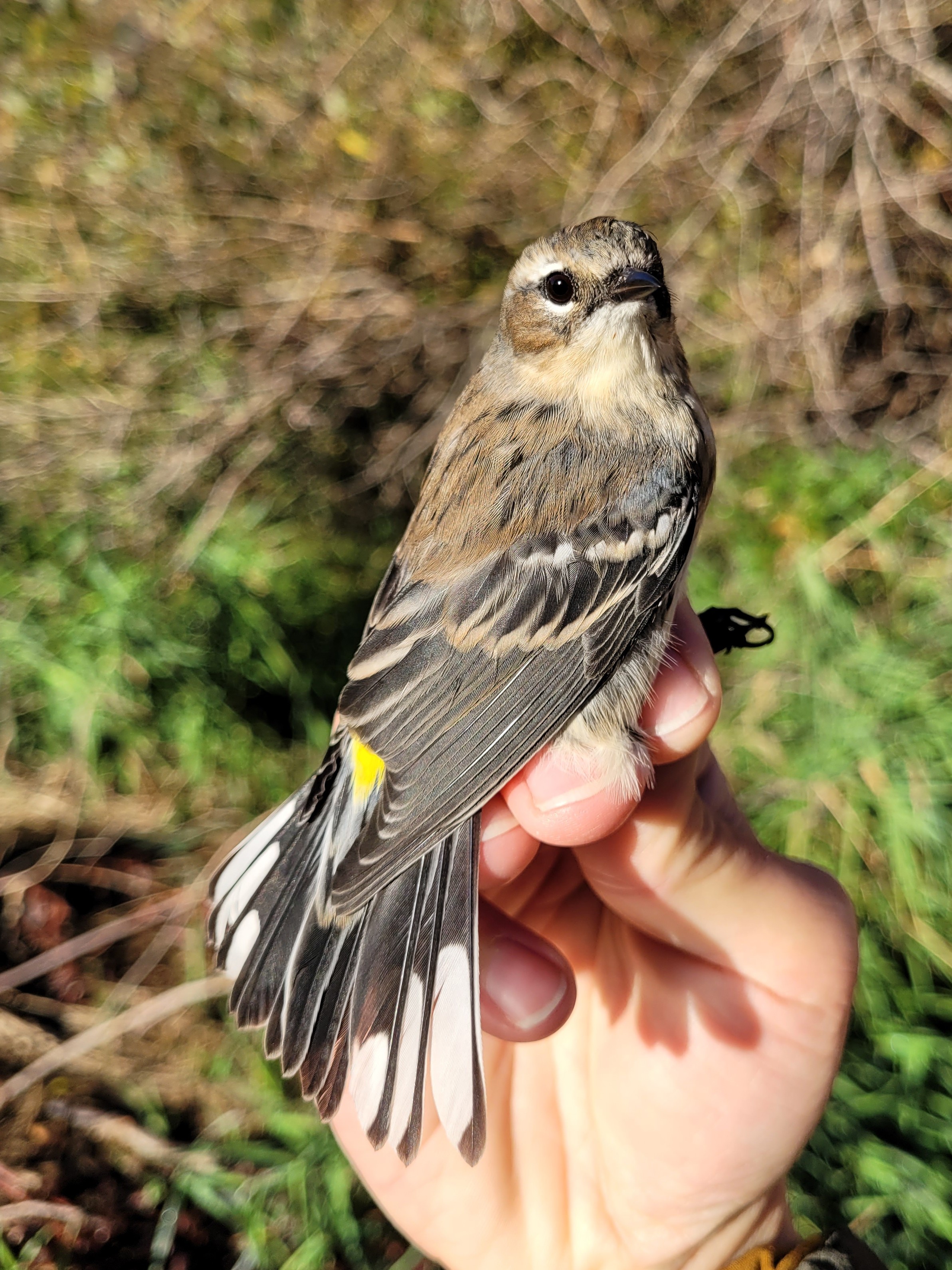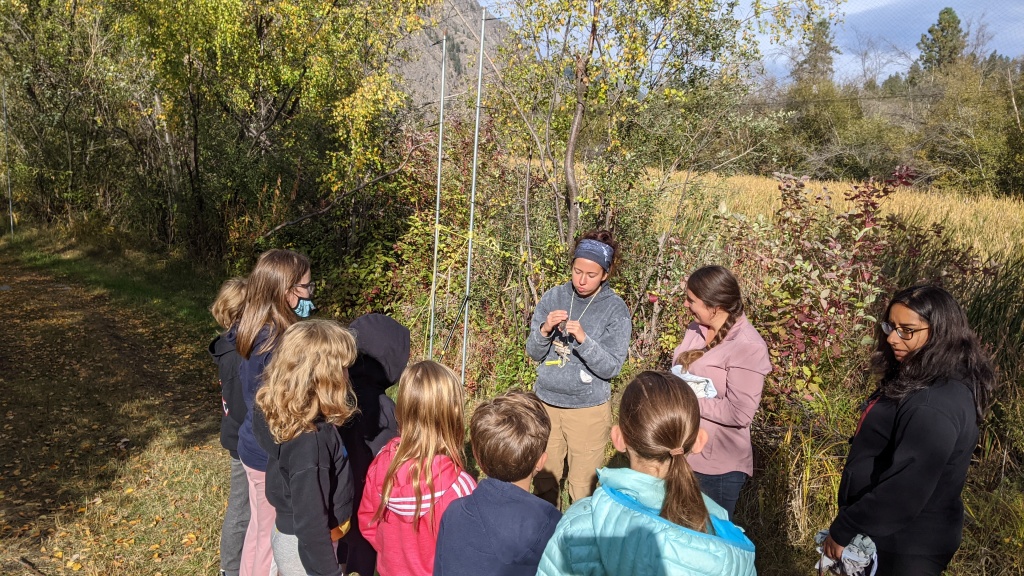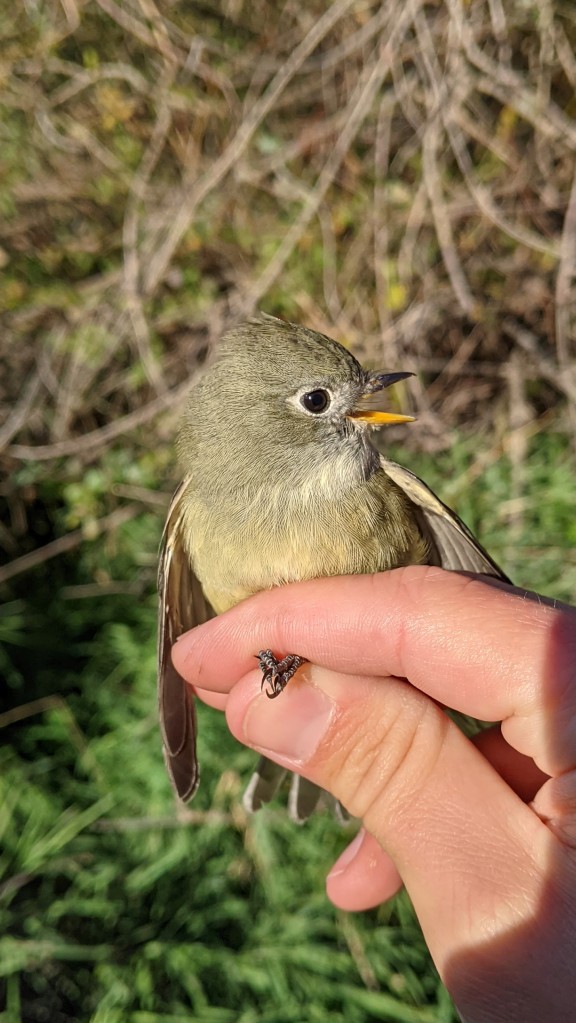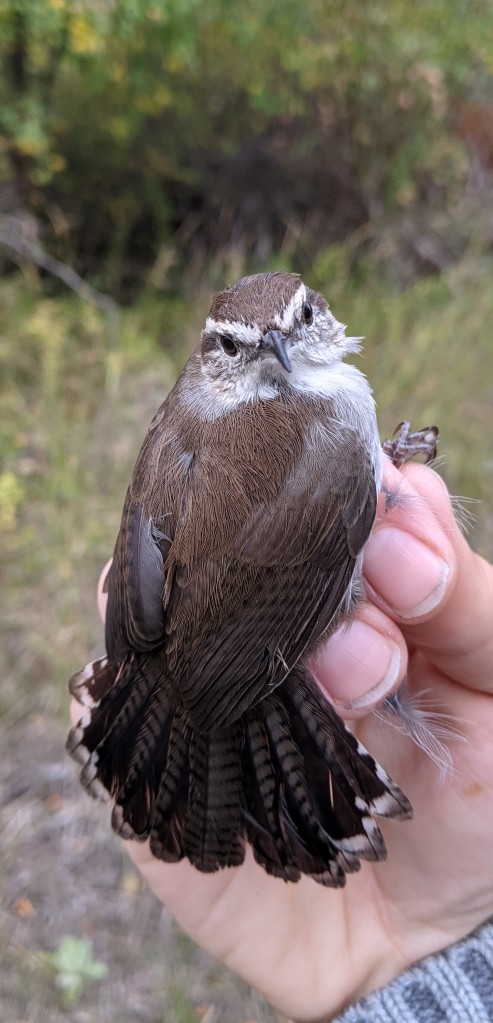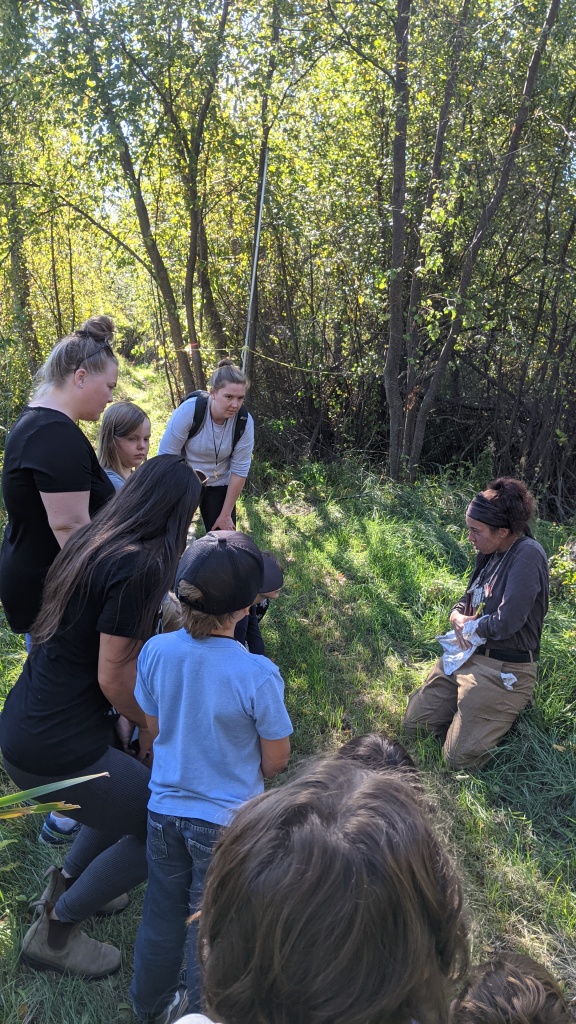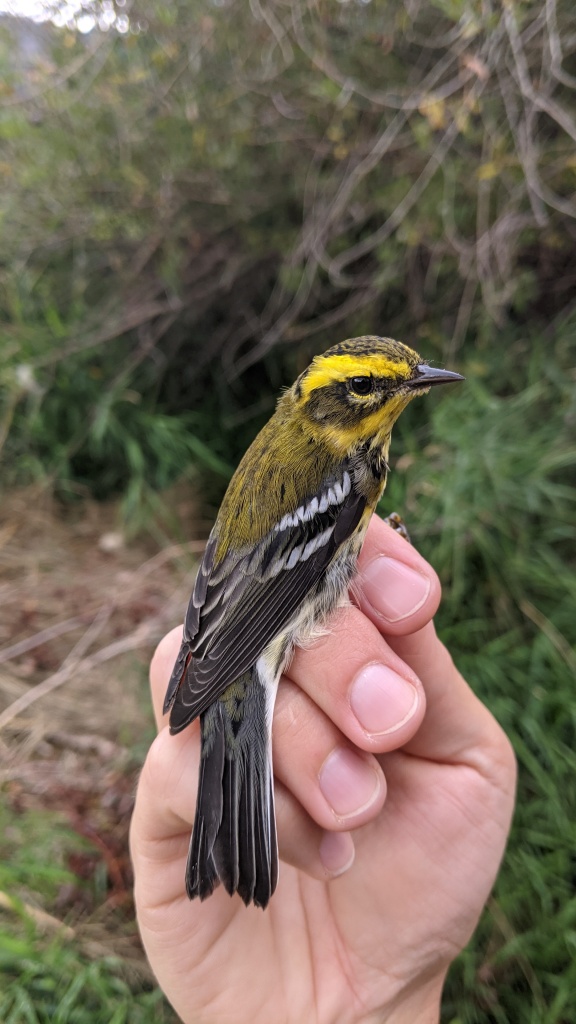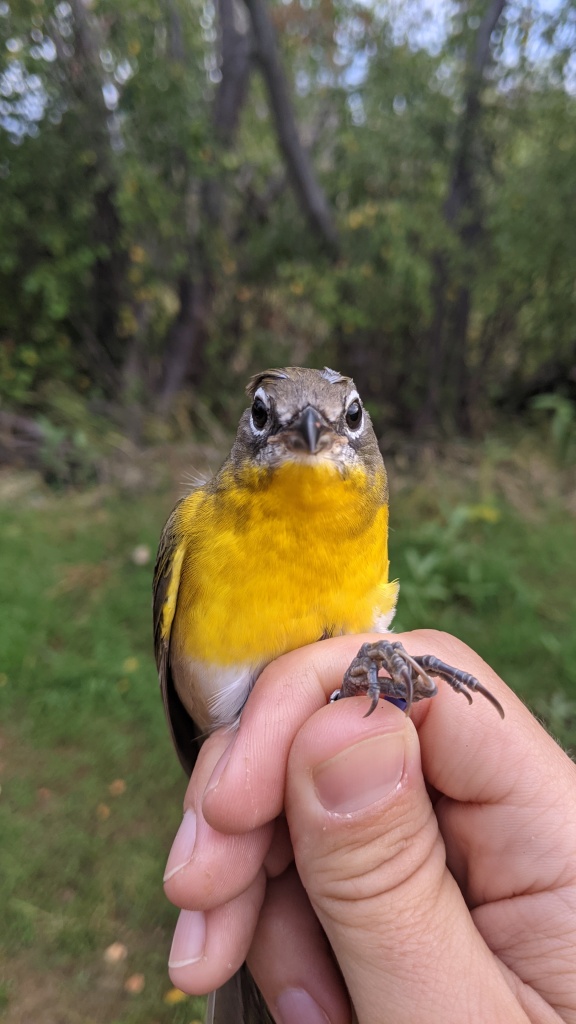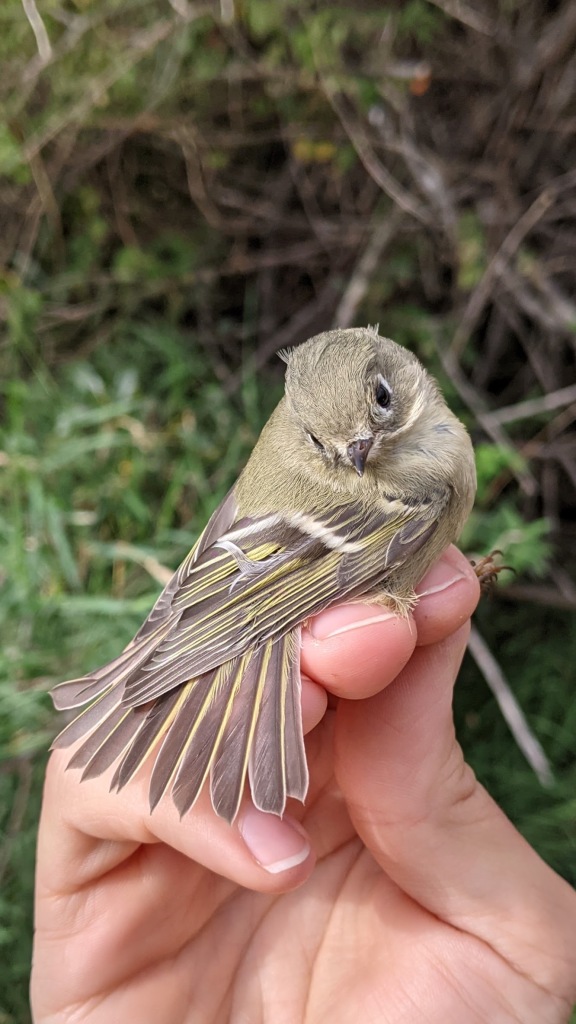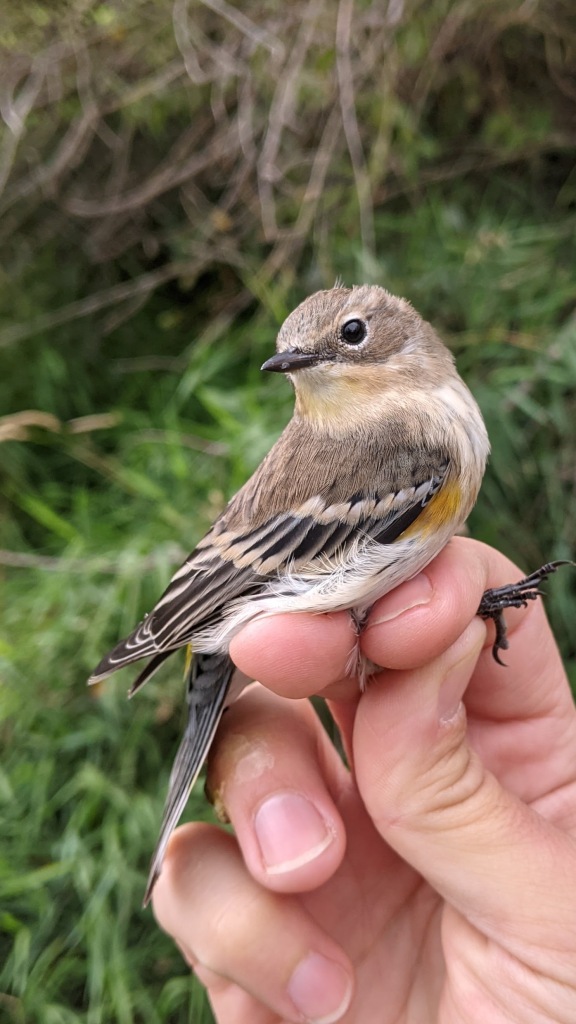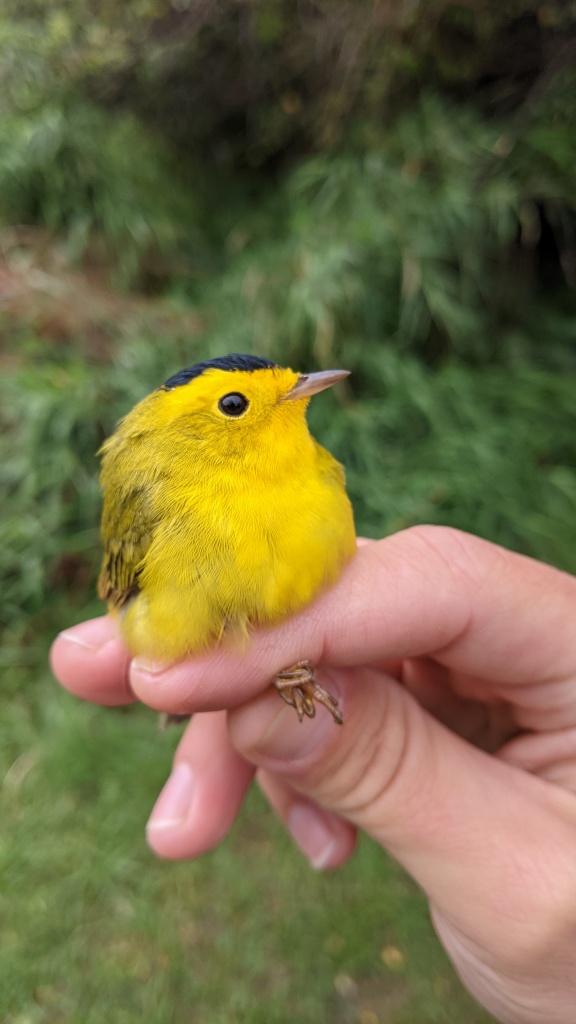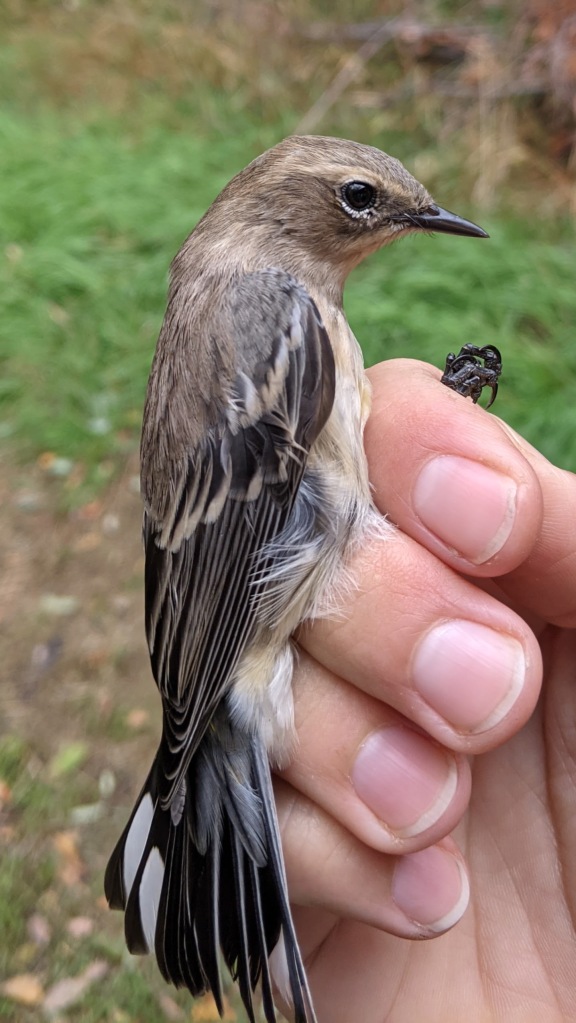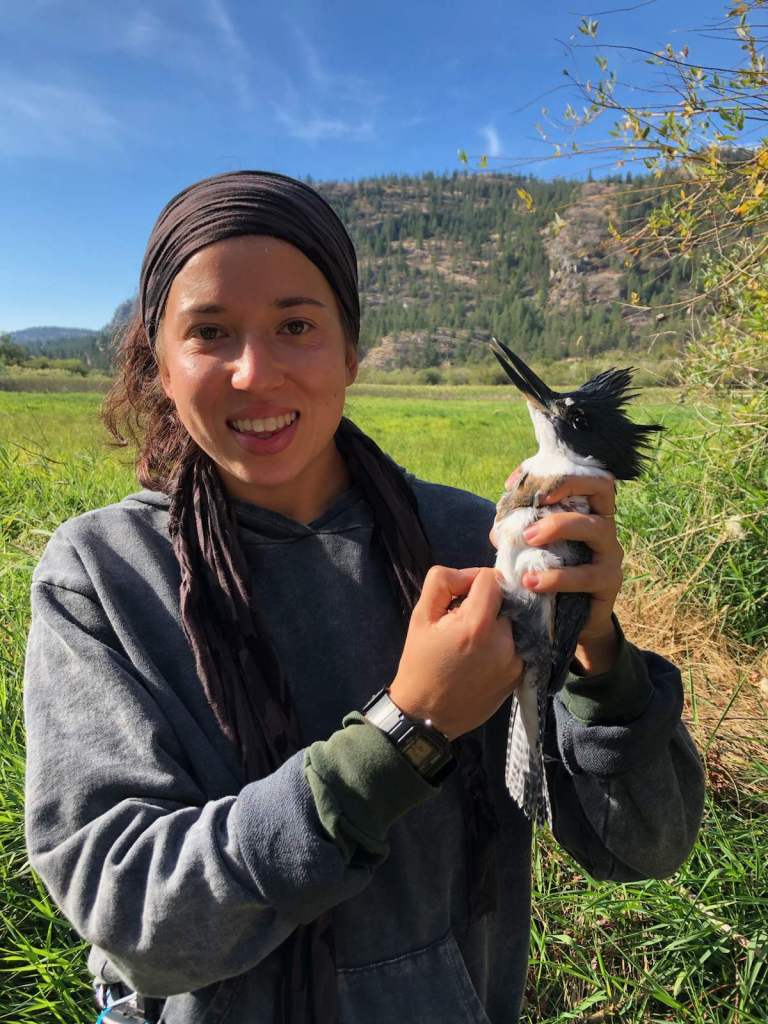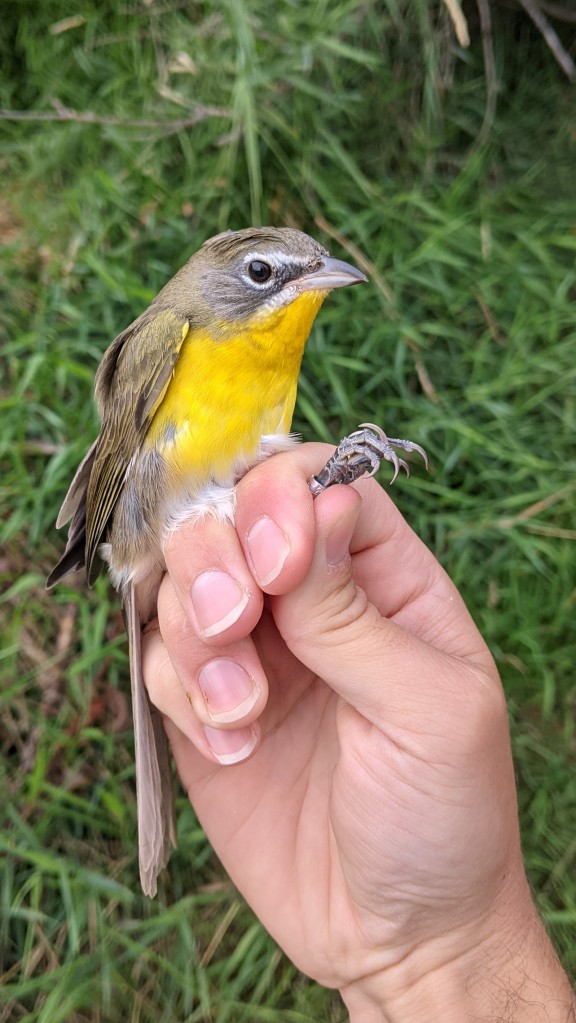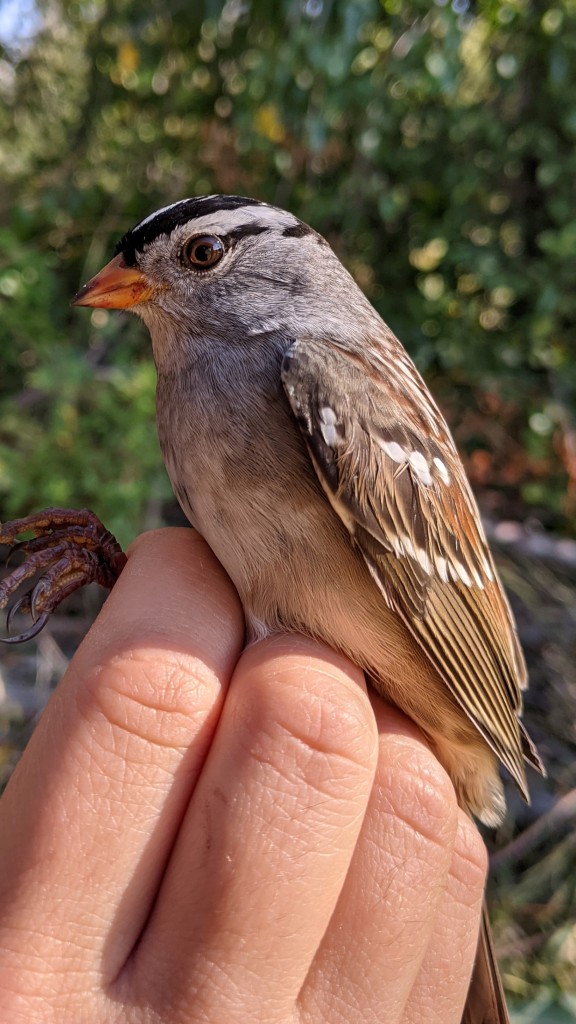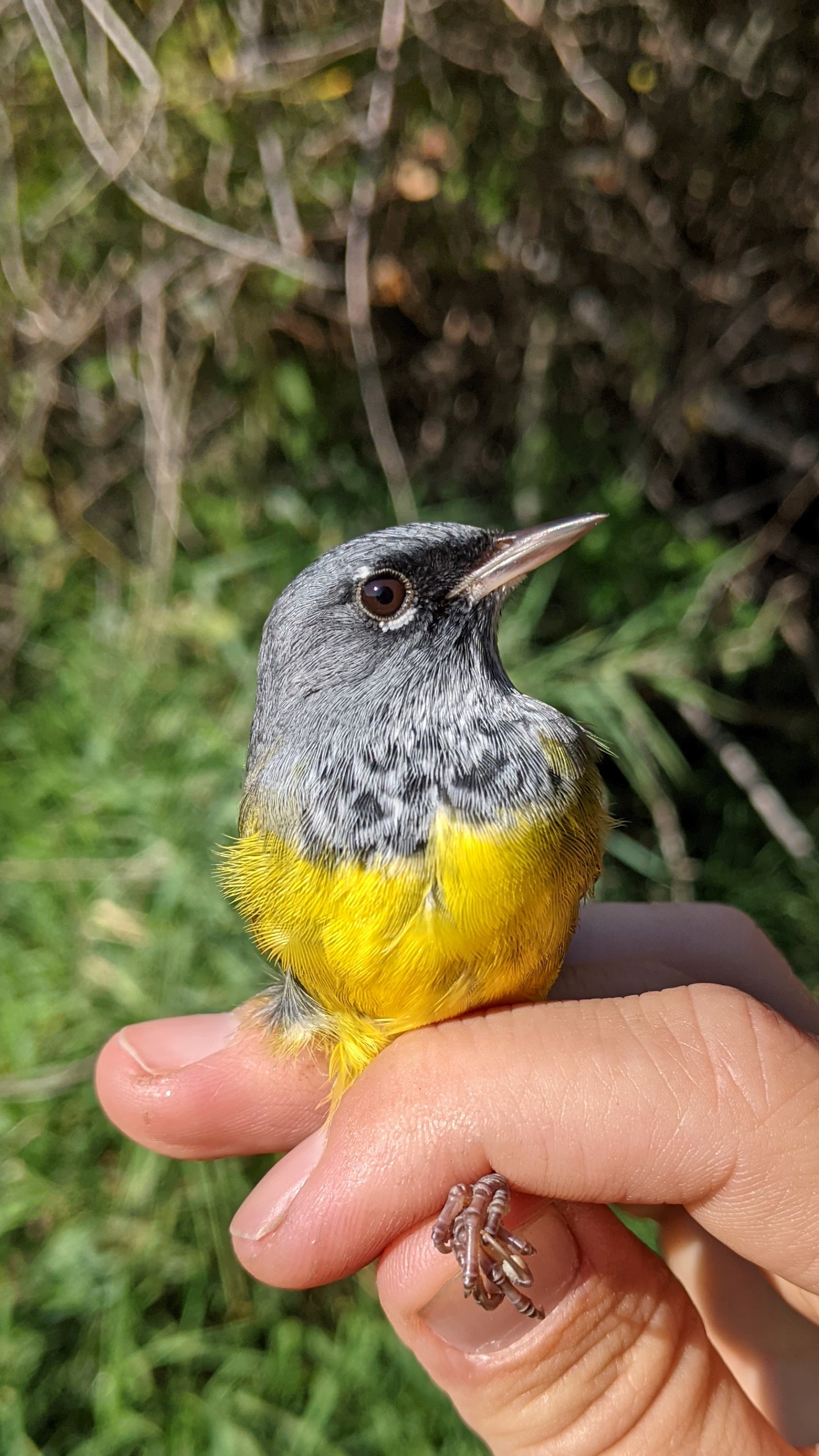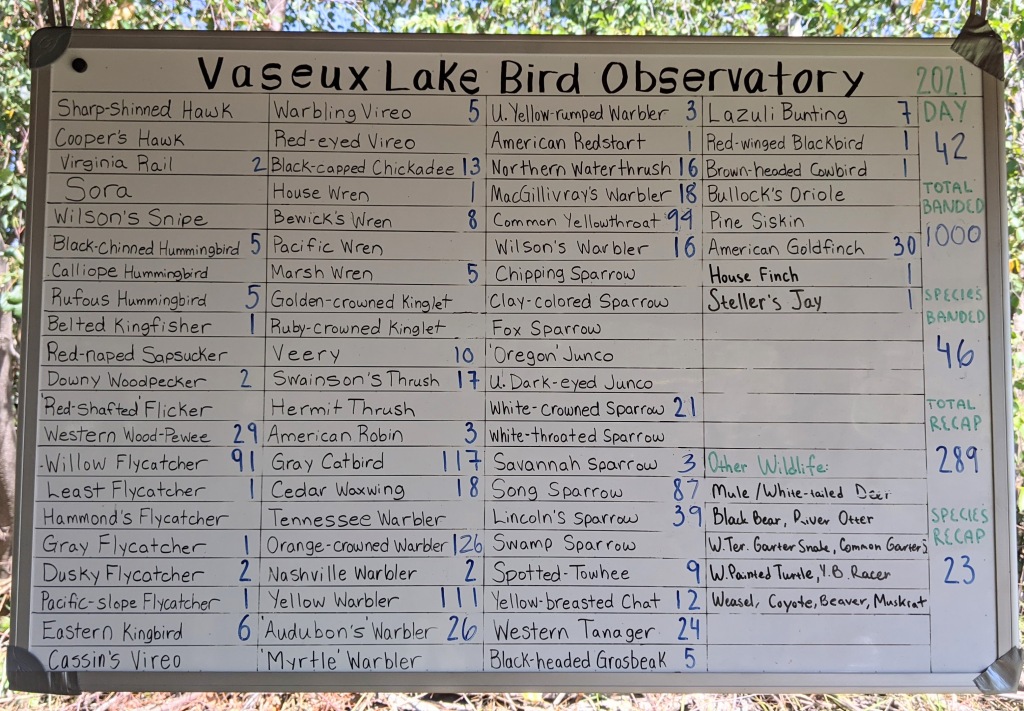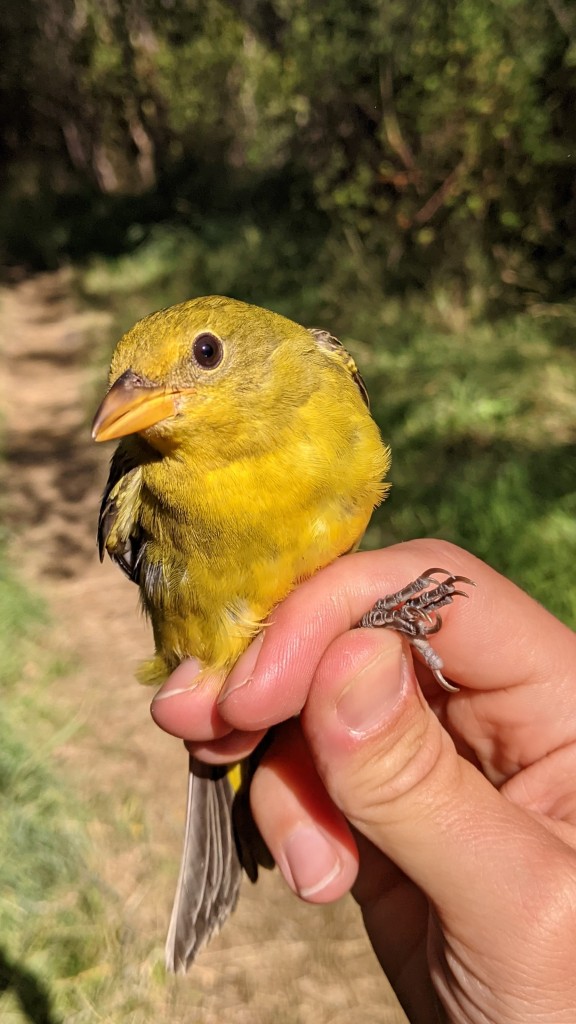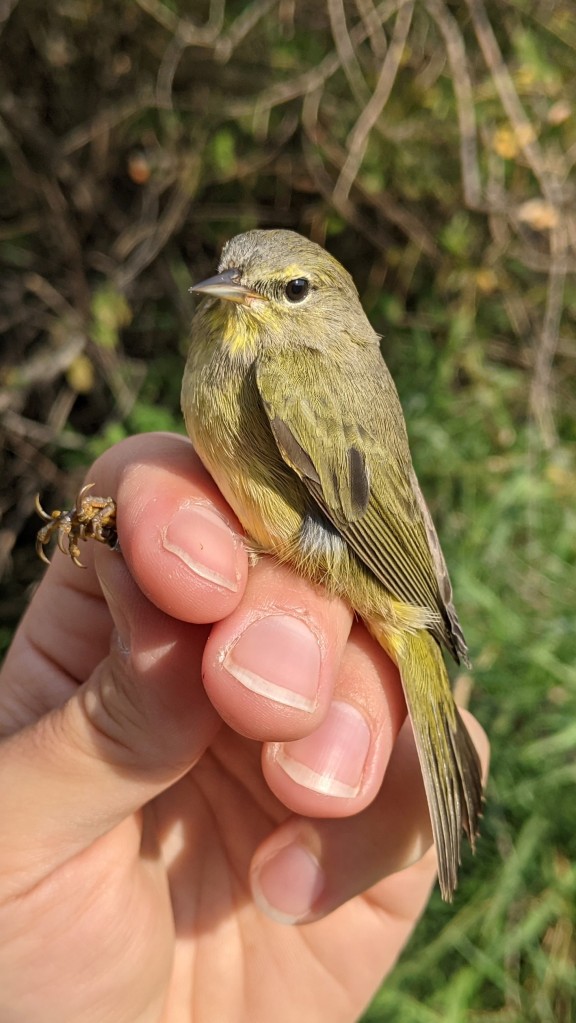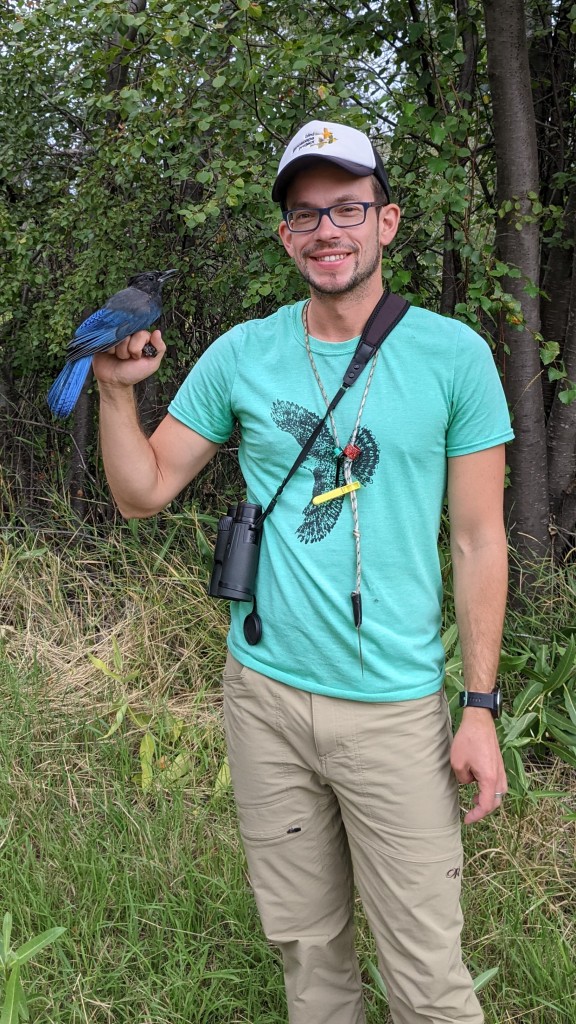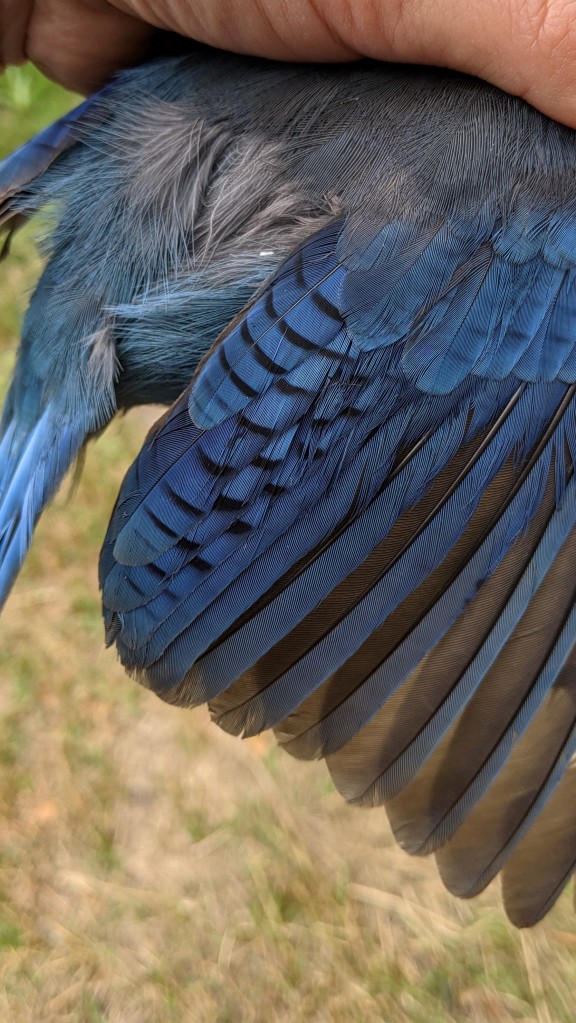2022, Week 2: Aug 8 – 14
Week 2 of VLBO’s 2022 fall migration monitoring program continued in similar fashion as the second half of week one with a relatively slow and steady pace. Overall we banded 156 birds of 27 species which is slightly below the week 2 mean of 185.5 birds. The busiest day was Friday with 31 birds banded while the slowest was Tuesday with only 17. It was a rather diverse week however with the number of species banded being slightly above the week 2 average of 24. This week we also recaptured 32 species of 9 species. We managed to opened two more nets this week as water levels continued to drop: nets 10 and 20; while nets 15 and 17 remain closed for now.



Highlights of the week were many as we banded one individual of several less frequent species, including a Gray Flycatcher, a threatened species found only in the Okanagan in Canada, a Hairy Woodpecker, a Pacific-slope Flycatcher and a Rufus Hummingbird! We also banded 3 more Yellow-breasted Chats, 2 MacGillivray’s Warbler, and interestingly, 5 juvenile Bewick’s Wren all on the same day! Perhaps they all fledged from the same nest that day.

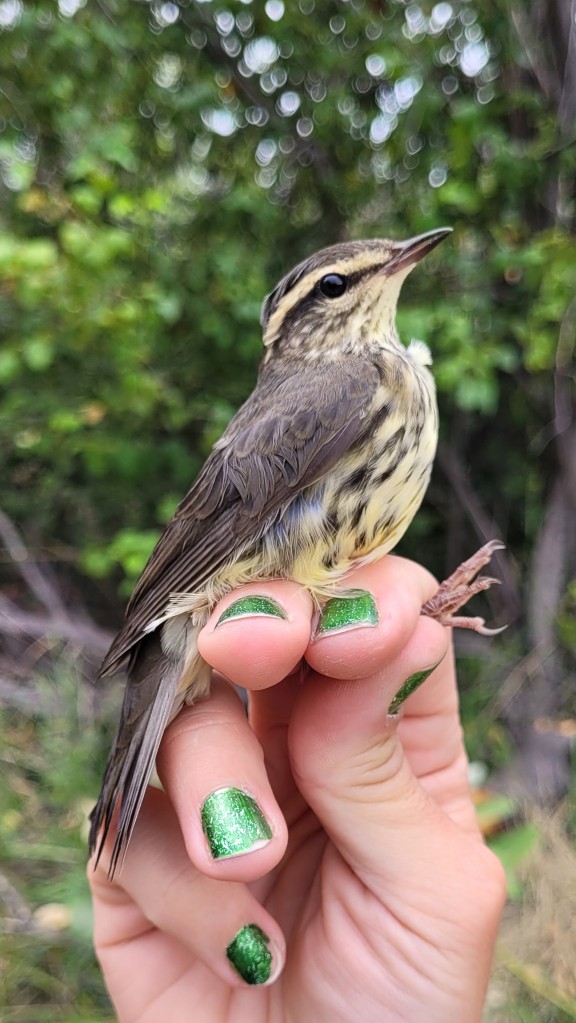

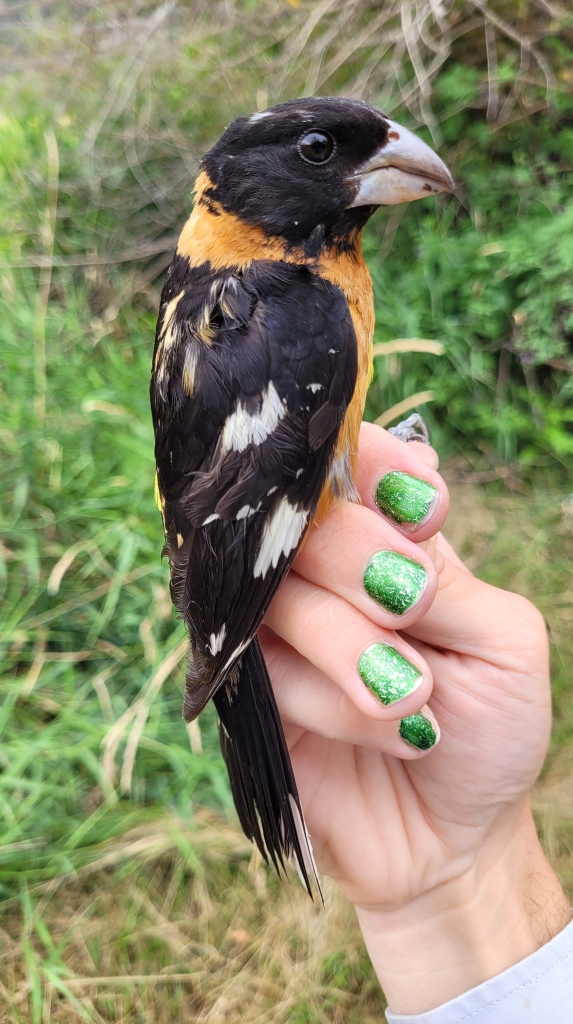
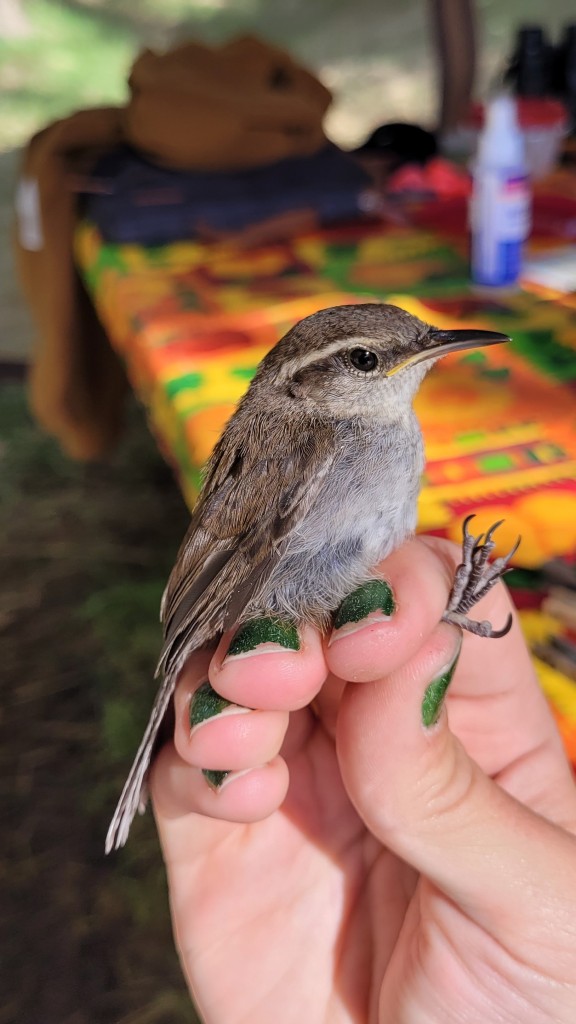
Yellow Warbler was the most banded bird this week with 26, followed by Willow Flycatcher with 25, Gray Catbird with 20 and Song Sparrow with 10. Northern Waterthrush was a big mover this week with 10 banded, up from zero last week. This species is one of our earliest migrants that does not also breed at the station, and we band on average 5 during week 1 so their movement through the area seems to be delayed by about one week. Black-headed Grosbeak also continued with higher than average numbers this week (with 4 banded), as were Veery (8) and Yellow-breasted Chat (3), while most other species were below average, particularly American Goldfinch and Cedar Waxwing. Song Sparrow, Yellow Warbler and Willow Flycatcher were close to average.
Below are the banding totals for Week 2.
| Species | Count |
| Yellow Warbler | 26 |
| Willow Flycatcher | 25 |
| Gray Catbird | 20 |
| Song Sparrow | 11 |
| Northern Waterthrush | 10 |
| Veery | 8 |
| Bewick’s Wren | 7 |
| Cedar Waxwing | 7 |
| Common Yellowthroat | 7 |
| American Goldfinch | 4 |
| Black-headed Grosbeak | 4 |
| Black-capped Chickadee | 4 |
| Yellow-breasted Chat | 3 |
| Marsh Wren | 3 |
| Wilson’s Warbler | 3 |
| Lazuli Bunting | 2 |
| MacGillivray’s Warbler | 2 |
| Gray Flycatcher | 1 |
| Hairy Woodpecker | 1 |
| Orange-crowned Warbler | 1 |
| Pacific-slope Flycatcher | 1 |
| Rufus Hummingbird | 1 |
| Spotted Towhee | 1 |
| Swainson’s Thrush | 1 |
| Virginia Rail | 1 |
| Western Wood-Pewee | 1 |
| Black-chinned Hummingbird | 1 |
| Grand Total | 156 |
2022, Week 1: Aug 1 – 7
The 2022 season of fall migration monitoring season is underway, and the first week is complete! It was a relatively slow one by opening week standards, with 254 birds banded of 26 species banded, and 38 birds of 9 species recaptured. Compared to the 10-year mean of 326 birds banded during week one, this is a well-below average start, though last year’s was even slower. Week one is typically one of our busiest, especially the first three days, as the station is busy with local nesting birds and their recently fledged young which have yet to be banded. The opening day was indeed busy as expected with 73 new birds and 82 total captures; however, this activity slowed considerably on the subsequent days with 44 and 40 banded on days 2 and 3, before dipping down to the around 20 birds per day by the end of the week. Water levels in the lake and surrounding marsh are still very high after a wet spring and early summer, which resulted in 5 of our net lanes being too flooded for us to put nets up. Net 19 dried quickly and was set up a few days later. Lower net effort certainly contributed to a slower opening week. Some smoke from nearby fires was present during the first few days but it mostly cleared up by day 5.



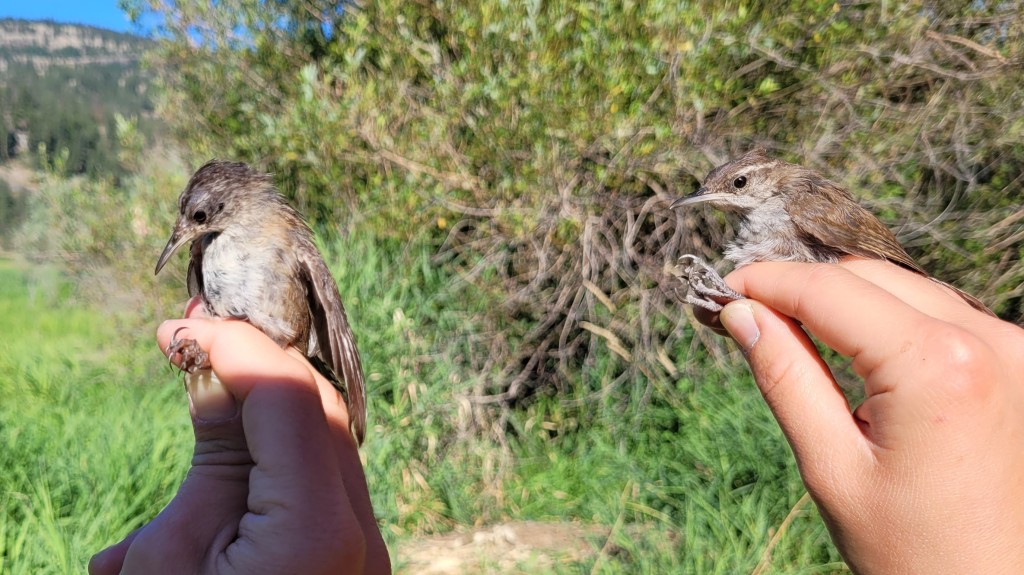
The biggest highlight of the week was a Cooper’s Hawk, a species we are lucky to get on average once a season! Other interesting captures included a Virginia Rail, 2 Yellow-breasted Chats, 2 Pine Siskin, which we don’t catch regularly, and a Rufus Hummingbird. The most frequently banded species of the week were Gray Catbird (40), Yellow Warbler (38), Song Sparrow (31), Cedar Waxwing (23), and Common Yellowthroat (23). Gray Catbirds were just below average for week one, while Yellow Warbler, Song Sparrow and Common Yellowthroat were just above average.
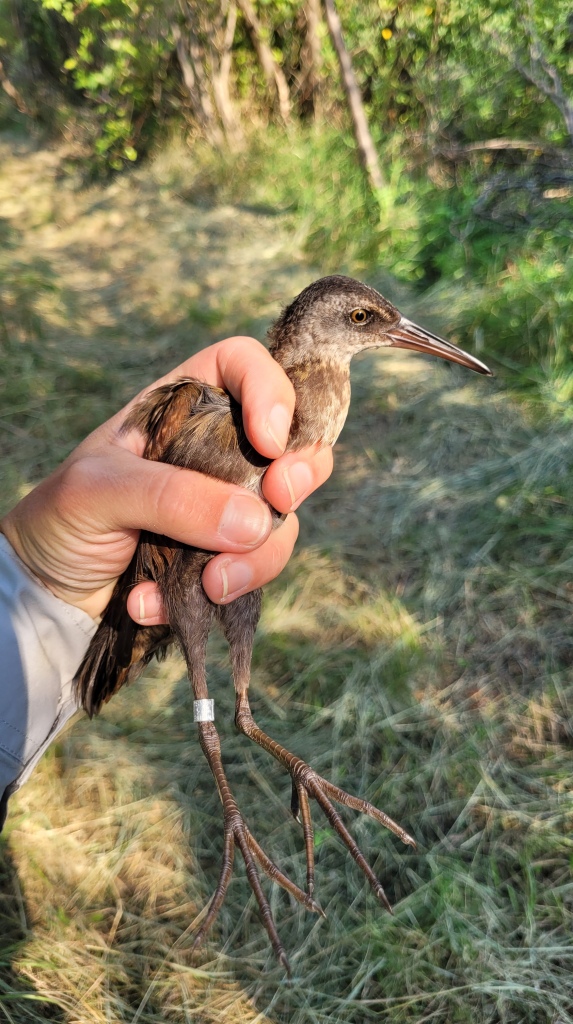
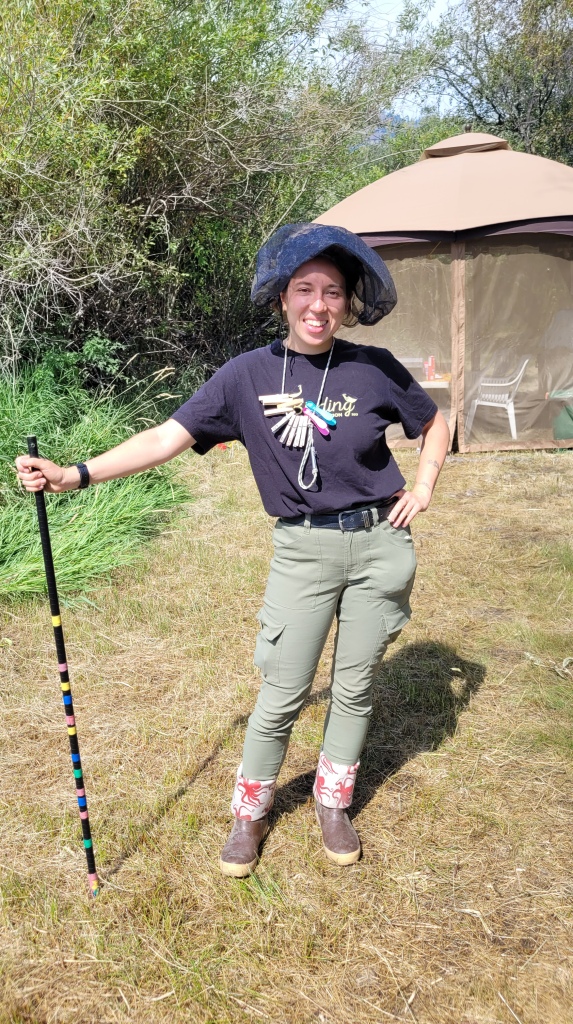
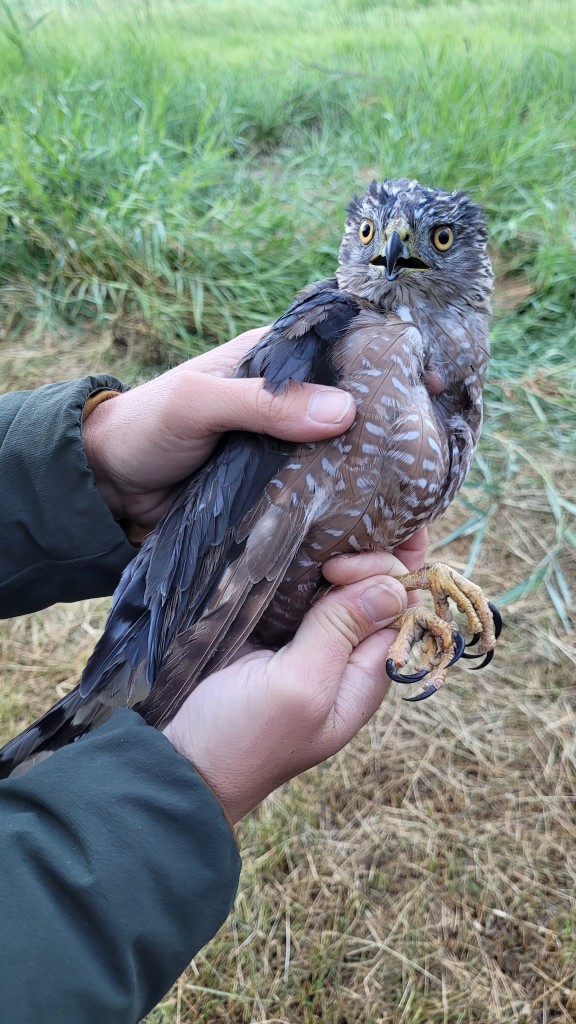
Season totals after week one below:
| Species | Number Banded |
| Gray Catbird | 40 |
| Yellow Warbler | 38 |
| Song Sparrow | 31 |
| Common Yellowthroat | 23 |
| Cedar Waxwing | 23 |
| American Goldfinch | 22 |
| Willow Flycatcher | 19 |
| Black-capped Chickadee | 8 |
| Marsh Wren | 7 |
| Veery | 6 |
| Western Wood-Pewee | 5 |
| Eastern Kingbird | 5 |
| Black-headed Grosbeak | 5 |
| American Goldfinch | 3 |
| Swainson’s Thrush | 3 |
| Downy Woodpecker | 2 |
| Yellow-breasted Chat | 2 |
| Brown-headed Cowbird | 2 |
| Pine Siskin | 2 |
| Lazuli Bunting | 2 |
| Rufus Hummingbird | 1 |
| Cooper’s Hawk | 1 |
| Lincoln’s Sparrow | 1 |
| Virginia Rail | 1 |
| MacGillivray’s Warbler | 1 |
| Bewick’s Wren | 1 |
| Grand Total | 254 |

2021, Week 11: Oct 10 – 15th
2021, Week 11: Oct 10 – 15th
Despite a slow end to last week, the final week of our migration monitoring season did not fizzle out as much as seemed likely. We banded 83 birds of 14 species which is quite good, considering it is a 6 day week and on typically the slowest week of the season (with an average of 65 birds). We recaptured 25 birds of 7 species including a very late House Wren that we banded back on September 25th. The week started very slowly with only 4 new birds on Sunday, thanks to high winds picking up suddenly during mid-morning. The next few days were pretty typical slow October days and poor weather conditions did not help. Very cold temps down to -5°C forced us to open late on Tuesday and early showers on Wednesday did the same. Finally, some calm but cool fall weather on the final two days of the season allowed for a strong finish. This was the third busiest Week 11 in the station’s history and the final two days were both record days with 25 and 28 birds banded on the Thursday and Friday, respectively, thanks to late flocks of yellow-rumps moving through.



The only new species for the week was a Sharp-shinned Hawk on the second last day which was long overdue! We normally catch a few of these each fall. Other highlights were 3 more Red-breasted Nuthatches, 2 Red-shafted Flickers, a 2nd Fox Sparrow as well as our 5th Virginia Rail!
Not surprisingly, ‘Audubon’s’ Warbler was the top species banded again with 17, followed closely by Song Sparrow with 15 and Lincoln’s Sparrow with 13. Ruby-crowned Kinglet rounded out the top 4 with 9 banded, which is above average for the first time this season. Overall, Yellow-rumped Warblers were far above the Week 11 average of 3.3 with 26 banded. Song Sparrow numbers were typical this week while Lincoln’s and White-crowned Sparrows were well above average. Oregon Junco were below average as were Common Yellowthroat and American Goldfinch which we didn’t encounter at all this week. Unfortunately we missed out on Swamp Sparrow, White-throated Sparrow, and Pine Siskin completely this season. We often band at least one or 2 of these late in the fall, but not every year.
And that’s it for the 2021 season! We finished with 2146 birds of 58 species which is actually a good total (the fourth highest ever, in fact!) considering how slowly the season started. However, the species total is a little below the station average of 60. Thanks to all the volunteers who lent a hand this year and keep an eye out for a season summary coming soon!
| Species | Number banded |
| ‘Audubon’s’ Yellow-rumped Warbler | 17 |
| Song Sparrow | 15 |
| Lincoln’s Sparrow | 13 |
| Ruby-crowned Kinglet | 9 |
| Unidentified Yellow-rumped Warbler | 6 |
| ‘Oregon’ Dark-eyed Junco | 4 |
| White-crowned Sparrow | 3 |
| ‘Myrtle’ Yellow-rumped Warbler | 3 |
| Red-breasted Nuthatch | 3 |
| Marsh Wren | 2 |
| ‘Red-shafted’ Northern Flicker | 2 |
| Wilson’s Warbler | 2 |
| Virginia Rail | 1 |
| Black-capped Chickadee | 1 |
| Sharp-shinned Hawk | 1 |
| Fox Sparrow | 1 |
| Total | 83 |
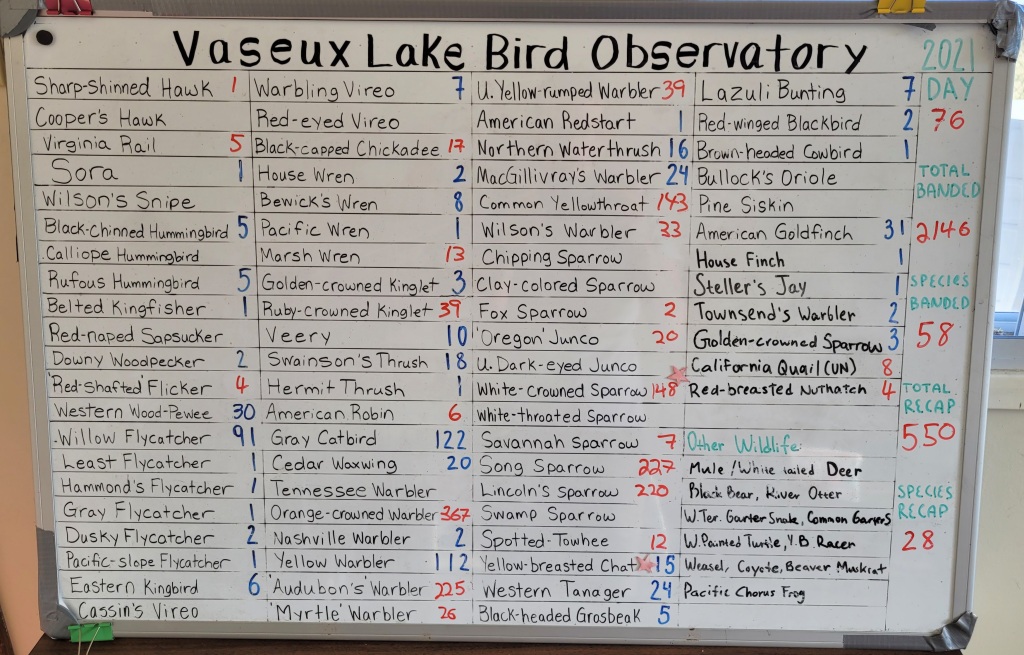
2021, Week 10: Oct 3 – 9th
The penultimate week of our fall season was very productive with 206 birds banded which is twice the average and a new station record for Week 10! It was not overly diverse, however, with only 13 species banded. We also recaptured 60 birds of 11 species. Week 10 was a week of two tails, with the first half being pleasantly productive, before bird activity slowed to a near halt by the end of the week. Surprisingly, we banded 60 birds on Sunday, which coincided with over 100 human visitors during our annual Open House. Wednesday was another very good day with 67 birds, the third highest total ever for a day in October. Then the numbers took a heavy dip on Thursday with 18 new birds and even more so on Friday and Saturday with only 12 and 4 new on those days, respectively. The nights of Wednesday and Thursday were cold and clear which likely meant that most of the remaining migrants in the area took that chance to clear the station. Friday morning we arrived at VLBO to heavy frost and -2.5 °C, our coldest morning yet!


With species diversity steadily dwindling we only banded one new species this week – Red-breasted Nuthatch – which puts our species total at 57, below the end-of-season average of 60. We are still missing a few late migrants which we typically catch at least one of in most seasons – Swamp Sparrow, White-throated Sparrow, and also Pine Siskin. However, we did pass 2000 birds banded on Sunday, which certainly did not seem a sure thing a few weeks back! In passing this milestone, we are now on track to finish on par with the more typical recent seasons for total birds banded, despite the lower diversity and low numbers in August.
Once again, Yellow-rumped Warblers made up a large proportion of the week’s birds with 71 banded in total in Audubon’s, Myrtle, and Intergrade forms. Song Sparrow came in second place with 38 banded, followed by White-crowned Sparrow with 30, and Lincoln’s Sparrow with 21. Another milestone this week was a new station record for White-crowned Sparrow with a total of 145 banded so far, surpassing the previous record of 122 set in 2006. This species is not nearly this abundant in most years with the station average being only 35. While being a very common migrant through the South Okanagan, they typically prefer drier habitat than what is found at VLBO. As one would expect with the high overall numbers, all of the top species were far above average this week, as were Orange-crowned Warbler with what is likely their final push. And once again, Ruby-crowned Kinglet were well below average in what is turning into a poor season for them.
With this week’s record total we are looking at a relatively productive October; though with the steep drop in numbers at the end of the week, we may see a very quiet end to the season during the final days.
The week’s totals are below.
| Species | Number Banded |
| ‘Audubon’s’ Yellow-rumped Warbler | 52 |
| Song Sparrow | 38 |
| White-crowned Sparrow | 30 |
| Lincoln’s Sparrow | 21 |
| Orange-crowned Warbler | 19 |
| ‘Oregon’ Dark-eyed Junco | 10 |
| Unidentified Yellow-rumped Warbler | 10 |
| ‘Myrtle’ Yellow-rumped Warbler | 9 |
| Ruby-crowned Kinglet | 6 |
| Common Yellowthroat | 3 |
| American Robin | 3 |
| Marsh Wren | 2 |
| Red-breasted Nuthatch | 1 |
| ‘Red-shafted’ Northern Flicker | 1 |
| Wilson’s Warbler | 1 |
| Total | 206 |

2021, Week 9: Sep. 26 – Oct. 2
During Week 9 of our fall migration monitoring program we banded 177 birds of 16 species which is above the overall station average for this week and on par with more recent years. The busiest day of the week came on Saturday, the final day of our week, with 46 banded which bodes well for the rest of October which can be quite slow. The daily totals were quite variable with the slowest day having only 12 birds while other totals were in the 20s and 30s. Similarly, weather conditions were also very inconsistent – we opened with temperatures in the teens on a couple occasions while several other mornings brought temperatures below 5°C. Not surprisingly, the busiest day came on a mild but overcast day with scattered showers. Wind was problematic on a few occasions with uncharacteristically strong gusts from the south forcing us to close our nets early on three different days. In fact, Thursday brought some of the strongest winds the South Okanagan has seen in recent memory and despite most of our nets being quite sheltered, we were only able to open a few for three hours. Banding totals would surely have been higher if not for these winds. Overall we recaptured 46 birds of 7 species with Song Sparrow being the most recaptured. The school program and other visiting groups were also in full swing this week as we hosted 130 visitors over 5 weekdays.
Despite species diversity declining as we near the end of the season, we still banded three new species this week! These were Fox Sparrow, Pacific Wren, and a Hammond’s Flycatcher – all typically later season specialties. Other highlights were our 4th Virginia Rail and 2nd Red-winged Blackbird of the season, and a rather late MacGillivray’s Warbler.
‘Audubon’s’ Yellow-rumped Warbler claimed the top spot this week with 47 banded as Orange-crowned Warbler dropped down out of first place for the first time in 4 weeks. Song Sparrow was second with 27, followed by Lincoln’s Sparrow with 25, both above average, and then Orange-crowned Warbler with 17, which is slightly below average. Good numbers of ‘Myrtle’ and ‘Unidentified’ Yellow-rumped Warblers (intergrades between the two subspecies or indeterminable individuals) were mixed in with the flocks of Audubon’s that passed through this week. Breeding in northern BC, Myrtles tend to arrive at the tail end of the season, compared to the Audubon’s, of which many of the individuals we catch early on likely breed locally at higher elevations. When combined, Yellow-rumped Warblers comprised over 40% of all birds this week with 74 banded which is far above average.
White-crowned Sparrow continued their productive season with three times average numbers while Ruby-crowned Kinglet and Marsh Wren continued to be below average, as was Common Yellowthroat this week.
The week’s totals are below.
| Species | Number Banded |
| ‘Audubon’s’ Yellow-rumped Warbler | 47 |
| Song Sparrow | 27 |
| Lincoln’s Sparrow | 25 |
| Orange-crowned Warbler | 17 |
| Unidentified Yellow-rumped Warbler | 16 |
| White-crowned Sparrow | 14 |
| ‘Myrtle’ Yellow-rumped Warbler | 11 |
| Ruby-crowned Kinglet | 6 |
| Common Yellowthroat | 4 |
| ‘Oregon’ Dark-eyed Junco | 2 |
| Marsh Wren | 1 |
| Fox Sparrow | 1 |
| MacGillivray’s Warbler | 1 |
| Red-winged Blackbird | 1 |
| Hammond’s Flycatcher | 1 |
| Pacific Wren | 1 |
| Spotted Towhee | 1 |
| Virginia Rail | 1 |
| Total | 177 |
2021, Week 8: Sep. 19 – 25
During Week 8 of our fall migration monitoring program we banded 384 birds of 24 species and recaptured 64 birds of 9 species. This was our busiest week of the season by far, even though we were completely rained out on Sunday! The total number of birds banded is almost twice the average for Week 8 and the third highest Week 8 total in the station’s history, after 2006 and 2019.



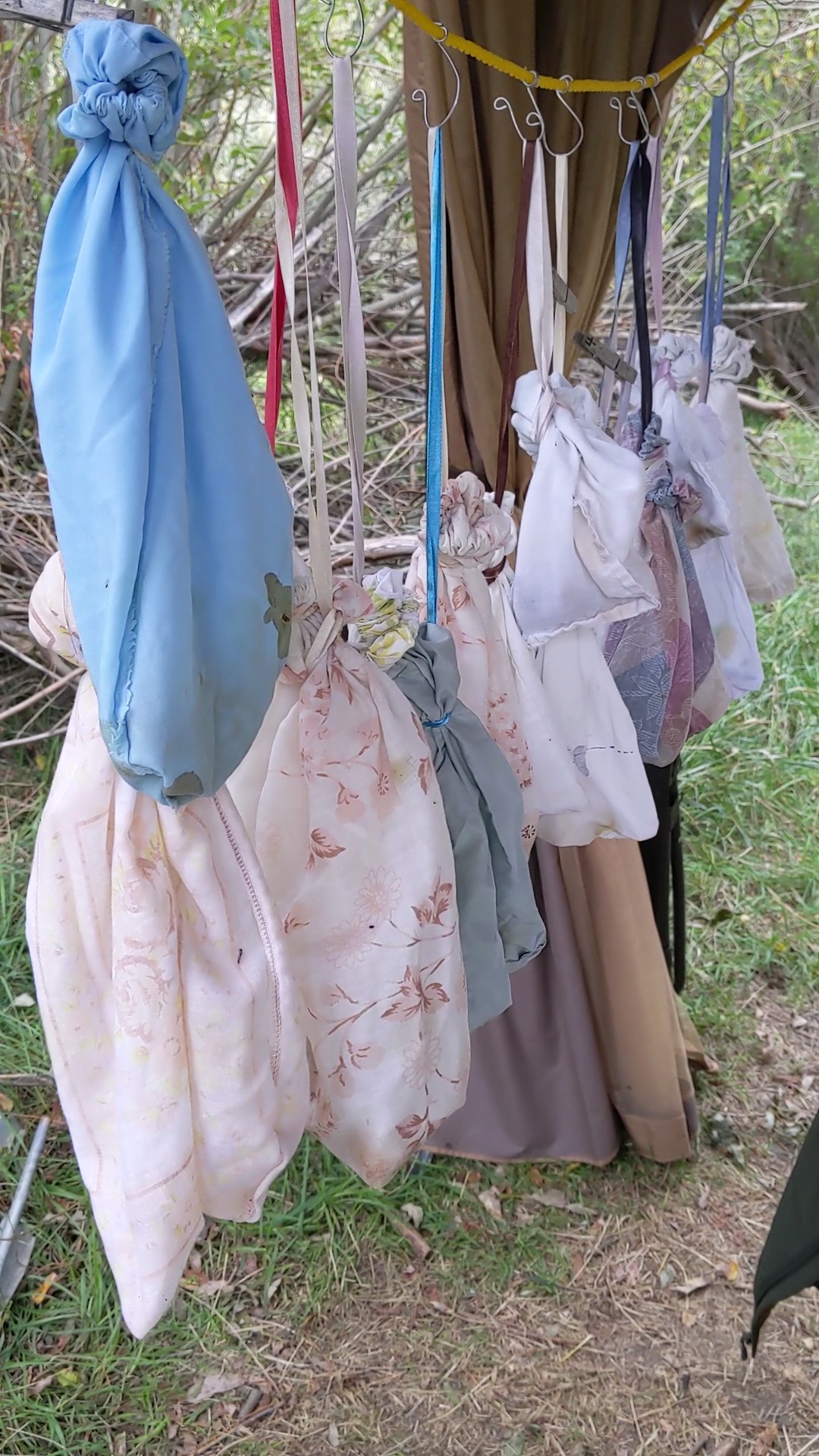
A storm passed through the area Saturday night and Sunday morning which led to massive fallout to start the week. Census in the rain on Sunday revealed dozens of sparrows, mostly White-crowns, around the station, which served as an alert a big day to come on Monday! Sure enough, we had by far our busiest day on Monday with 132 new birds and 11 recaps. In fact, it was the fifth busiest ever for VLBO! If that wasn’t enough, we also hosted a school group with 20 kids that day, one of 10 local school classes visiting the station this fall as part of OSCA’s Ecostudies program. Busy days continued for the rest of the week, albeit not quite like the first, with daily totals ranging from 60 to 79 total captures, before slowing down to 40 captures by the weekend. Without a doubt migration peaked this week, and will very likely slow down from here onward. We passed the season milestone of 1500 birds banded this week as well.

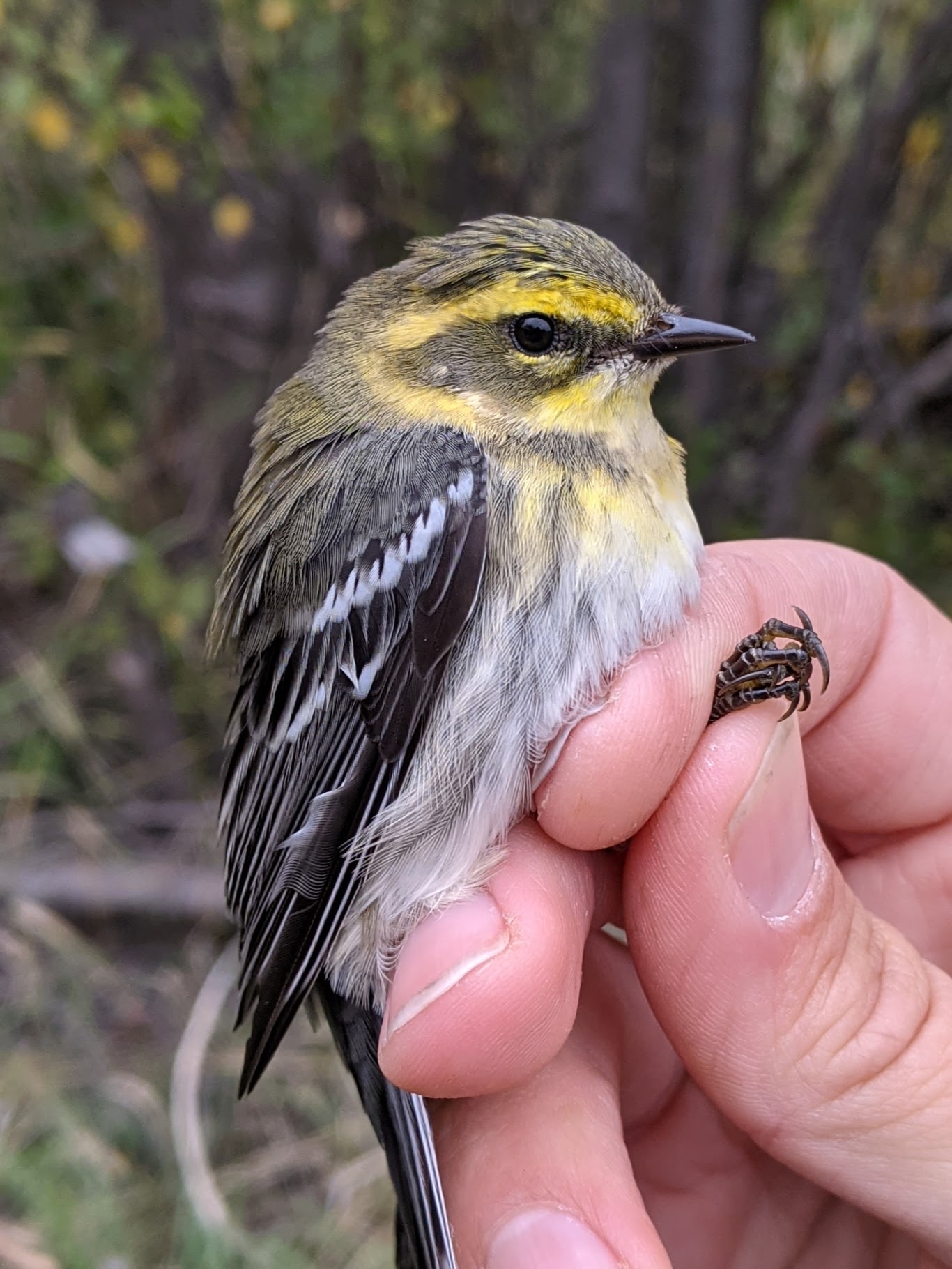

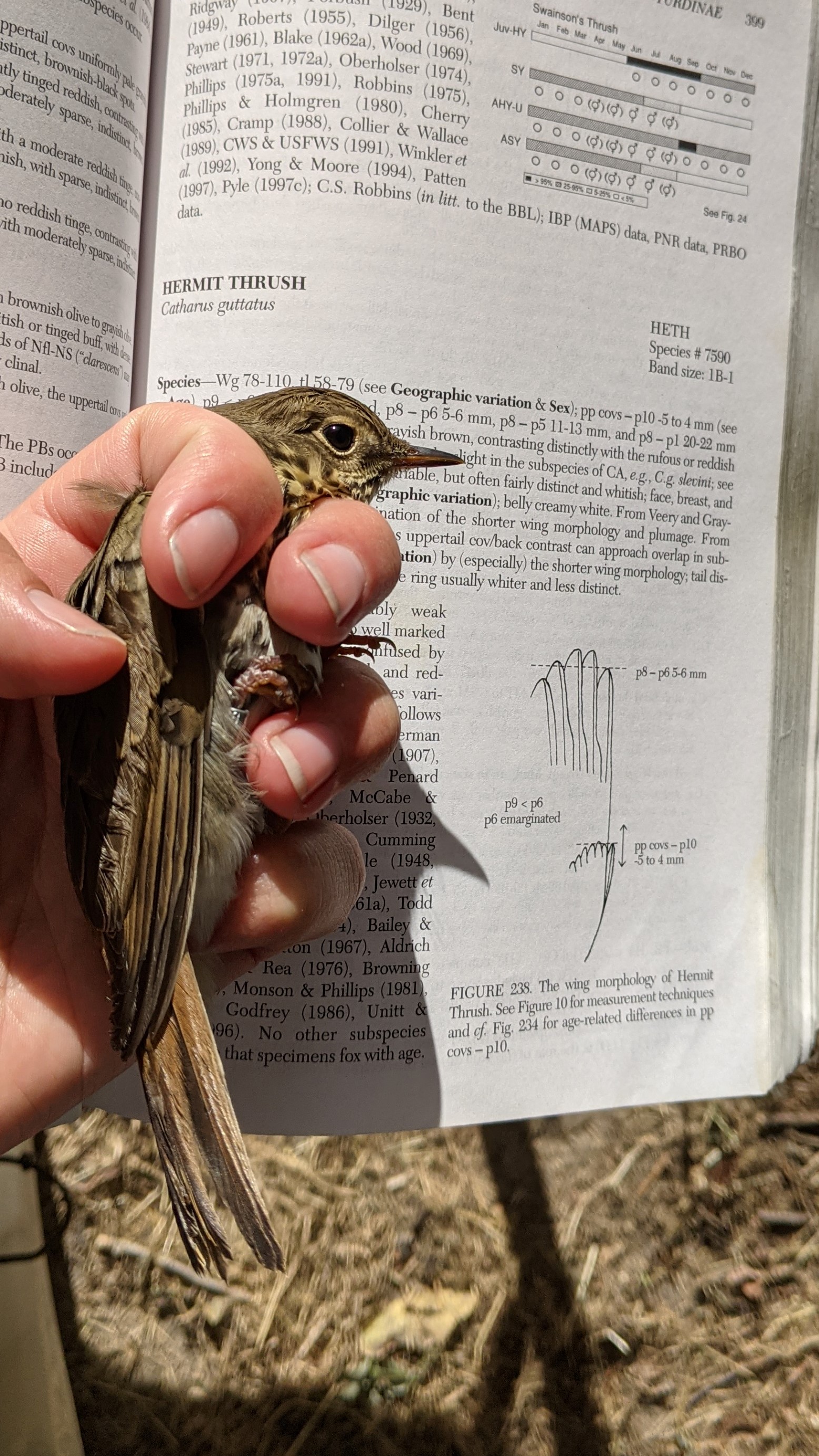
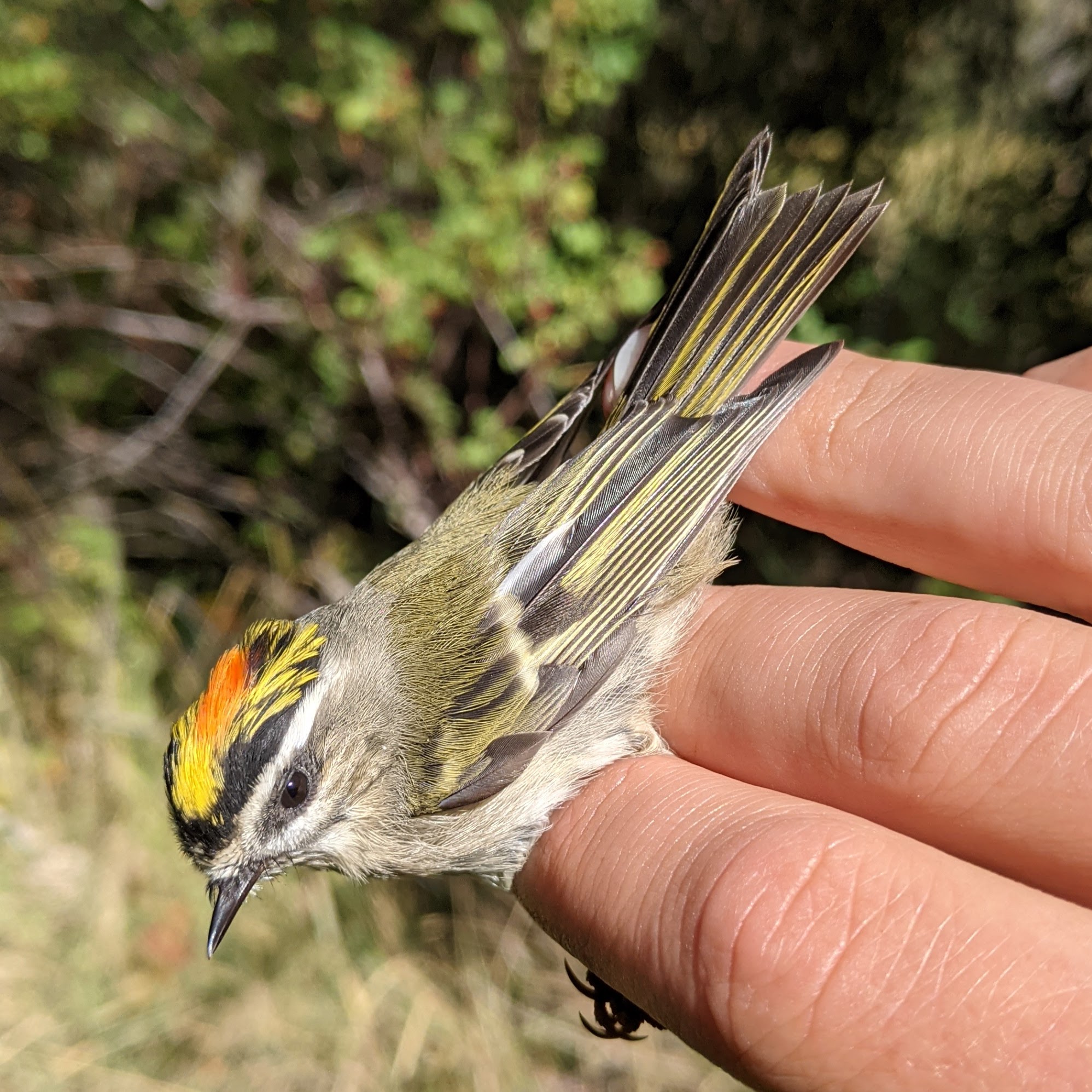

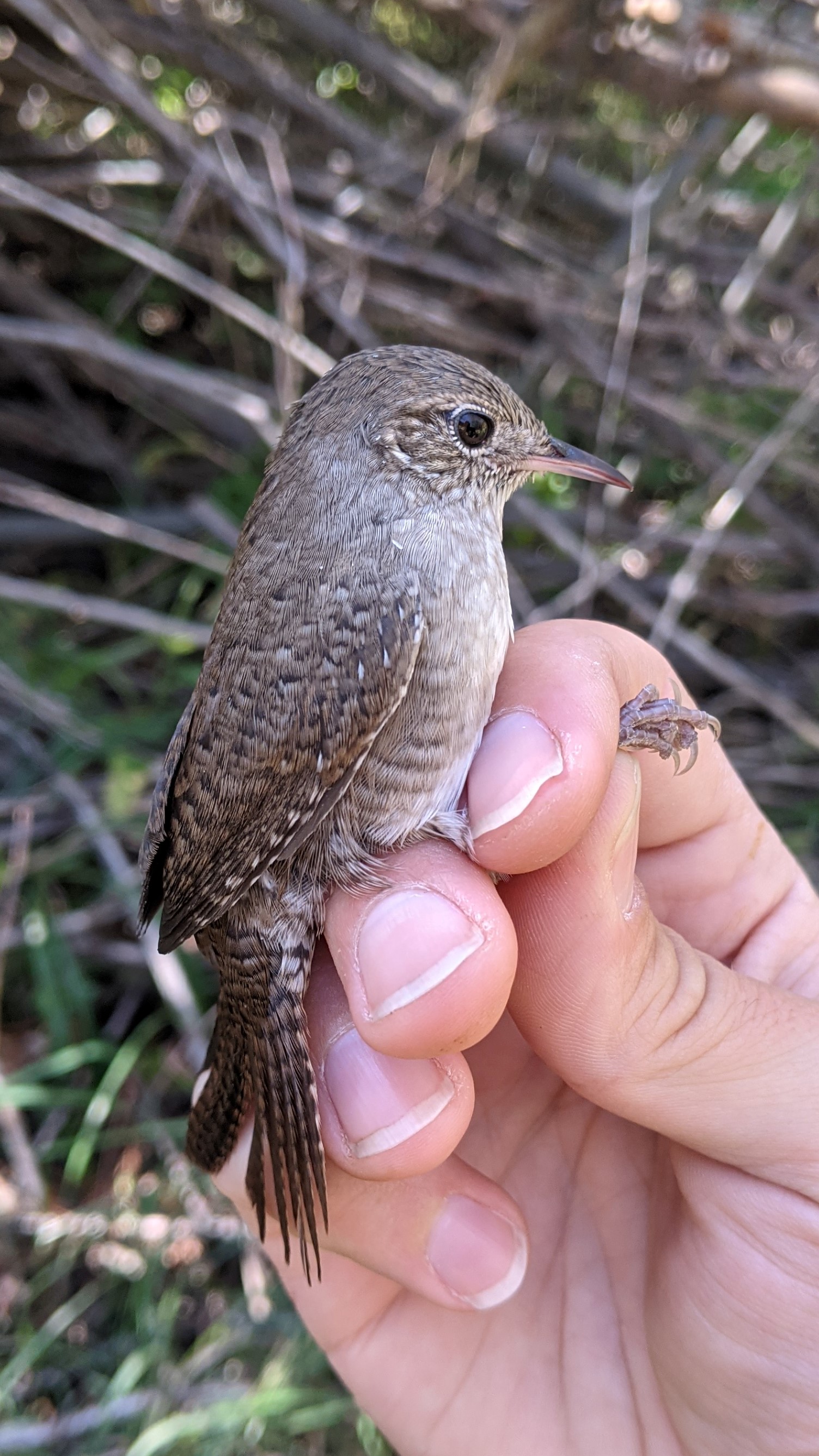
Highlights were many including 5 new species this week: Sora, Golden-crowned Sparrow (3), only the 4th to 7th recrods for VLBO(!), Golden-crowned Kinglet (4), ‘Oregon’ Dark-eyed Junco, and a Hermit Thrush! Other interesting birds this week were our 2nd each of Townsend’s Warbler and House Wren, our first Myrtle Yellow-rumped Warblers, and a late Western Wood-Pewee and Yellow-breasted Chat.
Orange-crowned Warblers continued their dominance with 110 banded, which is over twice the average for this week and makes up over a quarter of all birds banded this week. Following some distance behind were Lincoln’s Sparrow with 67, White-crowned Sparrow with 53, and Audubon’s Warbler with 51, all far above average, especially white-crowns which average only 10 for Week 8. Also above average were Wilson’s Warbler (for the first time), Song Sparrow, and Oregon Junco. Ruby-crowned Kinglet and Marsh Wren were close to par this week while Common Yellowthroat were below average.
It will be interesting to see how the rest of the season pans out with this relatively late peak now seemingly winding down.
The week’s totals are below.
| Species | Number Banded |
| Orange-crowned Warbler | 110 |
| Lincoln’s Sparrow | 67 |
| White-crowned Sparrow | 53 |
| ‘Audubon’s’ Yellow-rumped Warbler | 51 |
| Song Sparrow | 35 |
| Ruby-crowned Kinglet | 14 |
| Common Yellowthroat | 13 |
| Wilson’s Warbler | 9 |
| ‘Oregon’ Dark-eyed Junco | 4 |
| Golden-crowned Kinglet | 3 |
| Marsh Wren | 3 |
| Golden-crowned Sparrow | 3 |
| MacGillivray’s Warbler | 2 |
| ‘Myrtle’ Yellow-rumped Warbler | 2 |
| ‘Unidentified’ Yellow-rumped Warbler | 2 |
| Black-capped Chickadee | 2 |
| Gray Catbird | 2 |
| Spotted Towhee | 1 |
| American Goldfinch | 1 |
| Hermit Thrush | 1 |
| Townsend’s Warbler | 1 |
| Sora | 1 |
| House Wren | 1 |
| Western Wood-pewee | 1 |
| Cedar Waxwing | 1 |
| Yellow-breasted Chat | 1 |
| Grand Total | 384 |

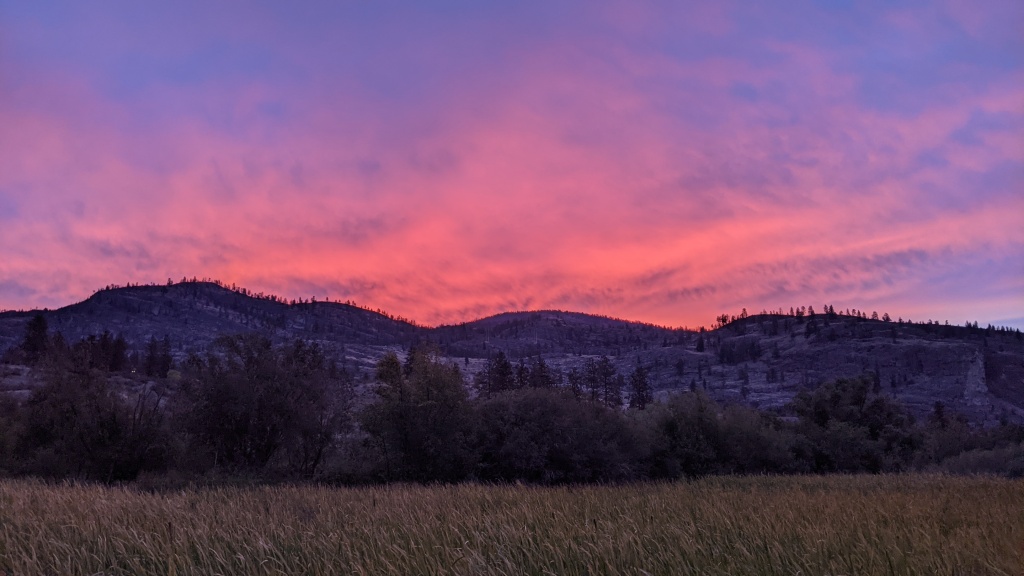
2021, Week 7: Sep 12 – 18
Week 7 of our fall banding season was the busiest so far with 295 birds banded which averages out to 42 birds per day! This total is well above the Week 7 average of 219 birds, and species diversity was right on average with 21 species banded. As has often been the case this season, strangely, the week started and ended with the busiest days being birds Sunday and Saturday with 64 and 65 birds on those days, respectively. The weather was all over the place this week with some very mild nights (temps in the teens), but also our coldest night of the season so far, as temps dipped down to 1.9 °C at the station and a light dusting of frost covered the reed canary grass! Cloudy skies were also more prevalent as the closing temp stayed below 20 °C on several days.
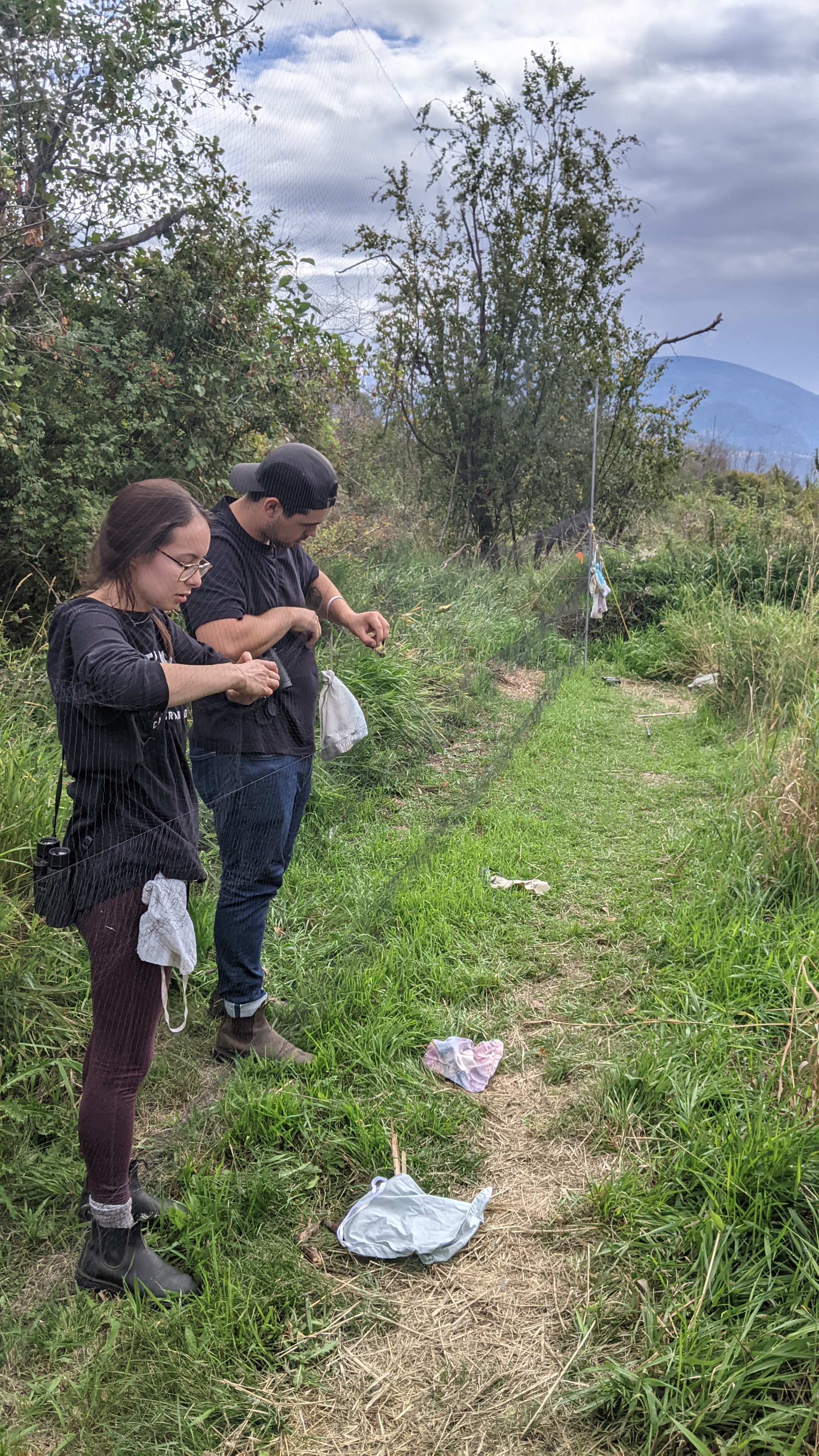

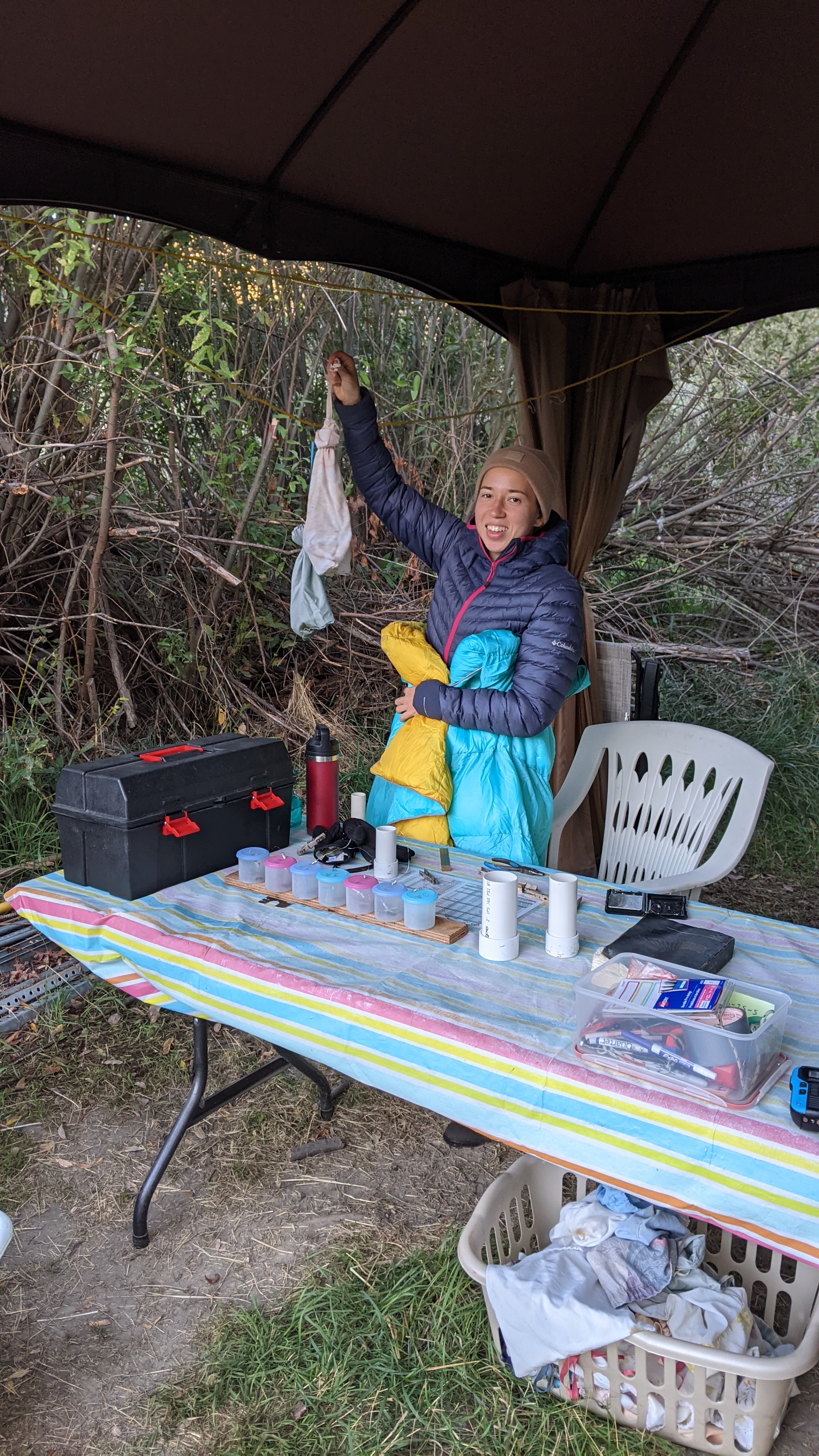
This week’s highlights include three new species: Townsend’s Warbler, ‘Red-shafted’ Northern Flicker, and Ruby-crowned Kinglet. We also banded our first ‘Myrtle’ Yellow-rumped Warbler and third Virginia Rail. And finally, we banded 2 more Yellow-breasted Chats which pushed them to a new season record of 15, passing last year’s record!
Orange-crowned Warblers once again led the charge this week with 95 banded, followed by Lincoln’s Sparrow with 55, and ‘Audubon’s’ Yellow-rumped Warbler with 32. These were all at least 1.5 times average for Week 7. Rounding out the top 4 was Common Yellowthroat with 29, which is only slightly above average. White-crowned Sparrow had another strong week with 27, which is close to 3 times average. If these numbers continue they may set a new record this year. Gray Catbirds are quickly petering out with only 3 banded, which is quite typical. Wilson’s Warbler again were below average with only 5 banded, and Ruby-crowned Kinglets have also been very slow to trickle in so far, though it’s still relatively early for them.
The week’s totals are below.
| Species | Number Banded |
| Orange-crowned Warbler | 95 |
| Lincoln’s Sparrow | 55 |
| ‘Audubon’s’ Warbler | 32 |
| Common Yellowthroat | 29 |
| ‘Gambel’s’ White-crowned Sparrow | 27 |
| Song Sparrow | 25 |
| Wilson’s Warbler | 5 |
| ‘Unidentified’ Yellow-rumped Warbler | 4 |
| Gray Catbird | 3 |
| MacGillivray’s Warbler | 3 |
| Ruby-crowned Kinglet | 3 |
| Yellow-breasted Chat | 2 |
| Warbling Vireo | 2 |
| Townsend’s Warbler | 1 |
| ‘Red-shafted’ Flicker | 1 |
| Yellow Warbler | 1 |
| Cedar Waxwing | 1 |
| ‘Myrtle’ Warbler | 1 |
| Savannah Sparrow | 1 |
| Swainson’s Thrush | 1 |
| Black-capped Chickadee | 1 |
| Virginia Rail | 1 |
| Spotted Towhee | 1 |
| Total | 295 |
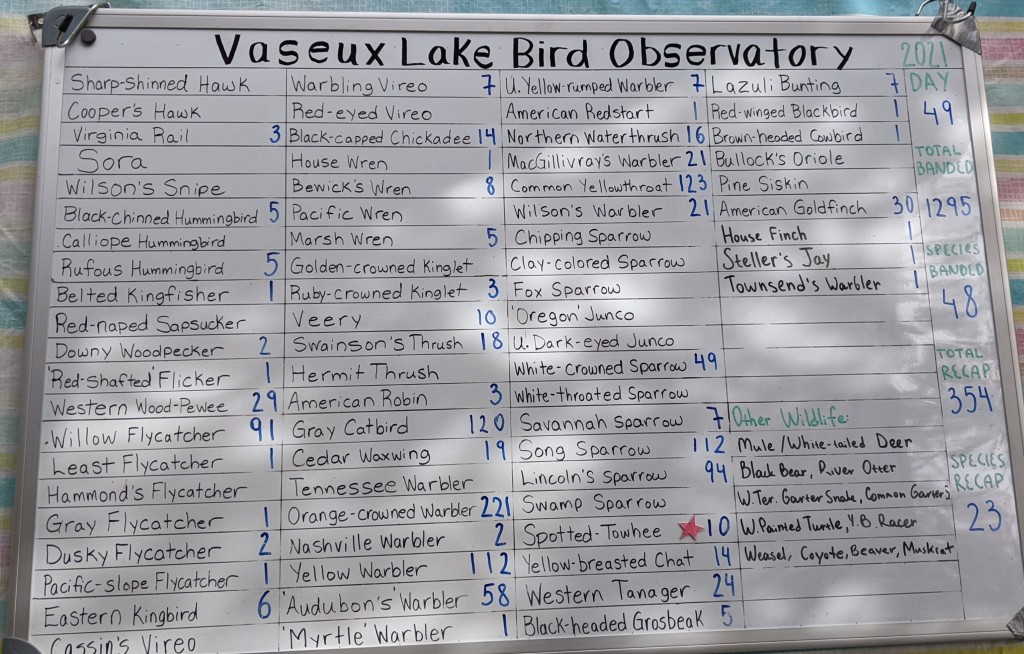
2021, Week 6: Sep 5 – Sep 11
Week 6 of our migration monitoring season continued the gradual upward trend of the previous week, concluding with 207 birds banded of 24 species, which is an above-average result, and our busiest week since Week 1. We also recaptured 54 birds of 12 species. The daily banding totals were pretty consistent through the week with a minimum of 20 birds banded on Wednesday and a max of 36 on Saturday. We finished the week with exactly 1000 birds banded for the season, which is slightly below the 20-year average and lowest running total after Week 6 since 2017. Temperatures were relatively mild during the week, with a few warm summer days reaching into the high 20s by noon and with little wind.



The biggest highlight of the week came on Monday when a Belted Kingfisher hit net 10! Kingfishers always make for an exciting moment of banding and several volunteers and visitors were on hand to witness the occasion. Other highlights included our season-first each of Pacific-slope Flycatcher and Red-winged Blackbird, and two stunning adult male MacGillivray’s Warblers. Red-winged Blackbirds have been flocking in large numbers in in the cattail marshes around the station, so it was only a matter of time before one hit the net. However, this happens surprisingly rarely, with only 1.6 bander per year, on average.
Orange-crowned Warbler maintained a large lead as the top species of the week, with 59 banded, which is again well above average. Song Sparrow moved up to second 31 banded, almost twice the average for Week 6, as migrant individuals join the residents of this species in the area. Common Yellowthroat and ‘Audubon’s’ Warbler came in third and fourth with 28 (close to average) and 19 banded (much higher than average), respectively. Gray Catbird, White-crowned Sparrow, and MacGillivray’s Warbler were also above average this week, while Wilson’s Warbler and Lincoln’s Sparrow were below average.
Yellow Warbler were conspicuously absent this week (they average 4.2 for Week 6), indicating that perhaps they completed their pass through our region early this year. We also banded no Marsh Wrens this week, and they have been surprisingly absent in our nets for much of the season so far.
Week 7 is typically the busiest in September so this momentum should continue into next week!
| Species | Number Banded |
| Orange-crowned Warbler | 59 |
| Song Sparrow | 31 |
| Common Yellowthroat | 28 |
| ‘Audubon’s’ Warbler | 19 |
| Gray Catbird | 15 |
| Lincoln’s Sparrow | 14 |
| ‘Gambel’s’ White-crowned Sparrow | 9 |
| Savannah Sparrow | 4 |
| Warbling Vireo | 3 |
| ‘Unidentified’ Yellow-rumped Warbler | 3 |
| MacGillivray’s Warbler | 3 |
| Swainson’s Thrush | 2 |
| Wilson’s Warbler | 2 |
| Yellow-breasted Chat | 2 |
| American Robin | 2 |
| Spotted Towhee | 2 |
| Pacific-slope Flycatcher | 1 |
| Belted Kingfisher | 1 |
| Western Tanager | 1 |
| Western Wood-pewee | 1 |
| American Goldfinch | 1 |
| Willow Flycatcher | 1 |
| Red-winged Blackbird | 1 |
| Cedar Waxwing | 1 |
| Black-capped Chickadee | 1 |
| Total | 207 |
2021, Week 5: Aug 29 – Sep 4
Migration picked up this week at VLBO with a considerable increase in the number of birds banded, compared to the previous few – we banded 182 birds of 27 species. This is above average for the first week this year, when taking into account that this is usually a relatively slow week. In fact, week 5 is typically the slowest week of all August and September, averaging 130 birds over our 20-year history. We also recaptured 61 birds of 12 species. The busiest day of the week was Sunday with 38 new birds and 12 recaps, while mid-week was slow before activity picked up again toward the end of the week. The trend of cool nights continued this week, though temperatures rose into the early-to-mid 20s by the end of the mornings with clear skies and fresh air without smoke!
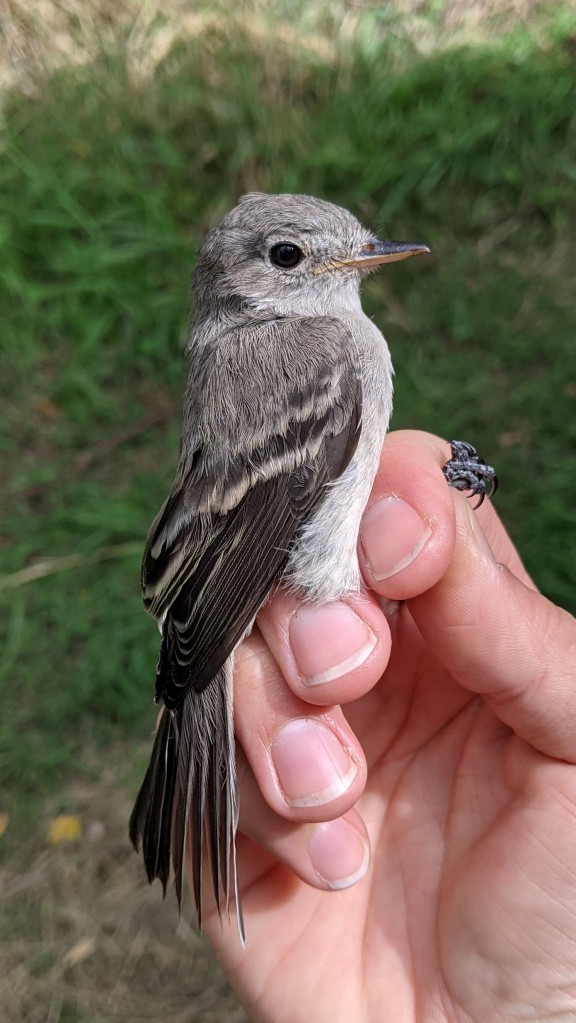
Gray Flycatcher 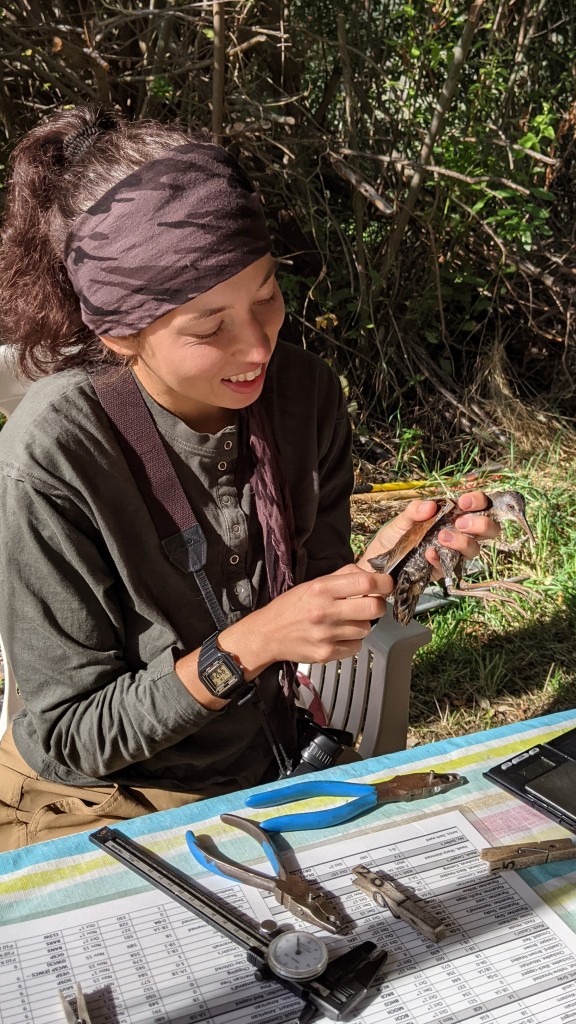
Assistant Bander, Anna, measuring the wing of a Virginia Rail
Two new species were banded this week: Gray Flycatcher, only the 15th ever banded at VLBO, and Dusky Flycatcher. Other exciting captures included our second Virginia Rail and Warbling Vireo, and three more Yellow-breasted Chats, the last of which was a station record tying 12th!
Orange-crowned Warbler jumped to the top of list this week, as expected this time of year, though 40 banded is more than twice the average. Common Yellowthroat was second with 31 which is also well above average, while Lincoln’s Sparrow (18), and Gray Catbird (16) rounded out the top four, both with very typical numbers for Week 5. White-crowned Sparrow, Western Wood-pewee, ‘Audubon’s’ Warbler, Western Tanager, and Swainson’s Thrush were also above average this week, while Willow Flycatcher and Wilson’s Warbler were below average. Could these results mean an earlier start to migration this year or is it just an isolated early push? We’ll see if the upward trend continues next week!
| Species | Number Banded |
| Orange-crowned Warbler | 40 |
| Common Yellowthroat | 31 |
| Lincoln’s Sparrow | 18 |
| Gray Catbird | 16 |
| Song Sparrow | 15 |
| White-crowned Sparrow | 9 |
| ‘Audubon’s’ Yellow-rumped Warbler | 6 |
| Yellow Warbler | 6 |
| Western Wood-pewee | 5 |
| Swainson’s Thrush | 4 |
| Wilson’s Warbler | 3 |
| MacGillivray’s Warbler | 3 |
| Western Tanager | 3 |
| Yellow-breasted Chat | 3 |
| Black-capped Chickadee | 3 |
| Willow Flycatcher | 2 |
| Dusky Flycatcher | 2 |
| Cedar Waxwing | 2 |
| Marsh Wren | 2 |
| Spotted Towhee | 2 |
| Warbling Vireo | 1 |
| Virginia Rail | 1 |
| Northern Waterthrush | 1 |
| Veery | 1 |
| Gray Flycatcher | 1 |
| American Goldfinch | 1 |
| Savannah Sparrow | 1 |
| Total | 182 |
2021, Week 4: Aug 22-28
The fourth week of our monitoring season has already passed and it was another slow week with 138 birds banded of 24 species. The weekly results have been surprisingly consistent so far with a range of only 126 – 138 birds banded across the last three weeks. Considering late August is typically a very slow time, this week’s total is actually in line with the Week 4 average of 131 birds. Feelings of fall were in the air this week with a drop to single-digit overnight temperatures and more mild daily highs. The week was off to a productive start with Monday being one of the busiest day of the season – with 45 total captures, before slowing down to the typical daily totals we’ve been seeing. We also recaptured 56 birds of 15 species, with Song sparrow being the most recaptured species.



New arrivals were White-crowned Sparrow with 3 banded on Aug 28th, and several less commonly banded species: American Redstart – the first in two seasons, House Wren, Least Flycatcher, and a Steller’s Jay – only the 5th ever banded at VLBO!
There was a change-up among the top banded species this week with Willow Flycatcher jumping to the top with 20 banded. This is somewhat surprising as the average for Week 4 is only 11.6 and lower than the previous weeks. Gray Catbird was second (18) but well below average, while Orange-crowned warbler climbed to third with over twice the average number banded (16), surpassing Yellow Warbler (13) which dropped to fourth, with an almost average total. Western Wood-pewee continued in far-above average numbers with 11 banded, as were Swainson’s Thrush and Wilson’s Warbler.


| Species | Count |
| Willow Flycatcher | 20 |
| Gray Catbird | 18 |
| Orange-crowned Warbler | 16 |
| Yellow Warbler | 13 |
| Western Wood-pewee | 11 |
| Song Sparrow | 11 |
| Common Yellowthroat | 11 |
| Wilson’s Warbler | 6 |
| Swainson’s Thrush | 6 |
| Lincoln’s Sparrow | 4 |
| Yellow-breasted Chat | 3 |
| White-crowned Sparrow | 3 |
| Veery | 2 |
| Northern Waterthrush | 2 |
| MacGillivray’s Warbler | 2 |
| American Goldfinch | 2 |
| Steller’s Jay | 1 |
| American Redstart | 1 |
| Western Tanager | 1 |
| Savannah Sparrow | 1 |
| Least Flycatcher | 1 |
| House Wren | 1 |
| American Robin | 1 |
| Rufous Hummingbird | 1 |
| Grand Total | 138 |



